Company growth is a lot like playing a game of telephone. The larger your group, the more convoluted and tangled the original story gets. And the more your company grows (both in revenue and people), the more disconnected teams become, making it harder to collaborate cross-functionally. That said, growth doesn’t just touch your headcount or ROI, it impacts your customer experience too.
This article will define sales and marketing alignment and illustrate how (and why) it’s important. Plus, we’ll include tips and tricks to help you successfully align your sales and marketing teams — or at least corral them into a similar trajectory, making both marketing and sales strategies more effective and efficient.
What is sales and marketing alignment?
Today’s customer has high expectations — of design, products, services, and overall experience— and for good reason too. They have to wade through countless options, products, and services to find the right one that best fits their wants and needs. So it makes sense for them to maintain a rigid sense of discernibility and heavily weigh the pros and cons of companies they choose to do business with.
For companies large and small, the thought of this can be utterly daunting. After all, there’s only so much control you can have.
But that’s where sales and marketing alignment comes into play.
For all intents and purposes, sales and marketing alignment can be loosely defined as when marketing and sales teams share goals and work together to generate revenue.
While marketing and sales will still have distinct roles, aligning around the same goal ensures marketing and sales are communicating, guiding each other’s strategy and ultimately being more efficient.
Why is sales and marketing alignment important?
Aside from storing grain or water, silos aren’t good for much. Ultimately, silos prevent your sales and marketing teams from working together to achieve common goals — i.e. growing company revenue.
However, on a smaller scale, silos not only bottleneck workflows, but it hampers sales cycles, strategic goals become muddy, and sales teams aren’t able to make the most of the marketing leads, so your marketing team’s efforts get passed by the wayside and are underutilized.
At this point, it probably goes without saying that none of this is ideal.
Sales and marketing alignment helps prevent this. 87% of sales and marketing leaders say collaboration between sales and marketing enables critical business growth, and 90% agree that when initiatives and messaging are aligned the customer experience is improved.
What are some other benefits of sales and marketing alignment?
- Better equipped sales teams — When your sales and marketing teams are truly aligned and chatting regularly, your sales reps will be better prepared with the marketing materials they need to get through to leads.
- Clearer understanding of your customers — Another benefit of alignment is that sales can give regular feedback about what problems their leads are looking to solve. This will give your marketing a team a better understanding of your customers and will lead to more specific and effective buyer personas.
- Improved employee engagement — When teams are aligned and communicating, people feel heard. Both your sales and marketing employees will know your company is listening to their expertise and values them, which leads to overall improved employee engagement and satisfaction.
- Less frustration all around — Teams who talk to each other will eventually figure out a good way to communicate and work together — decreasing frustrations, silos, and misunderstandings.
- More sales and faster sales — And of course, when your sales and marketing teams are operating efficiently together, you’ll be making more sales and doing so faster. That’s the number one benefit of a well-equipped sales team.
To align your sales and marketing teams, there are a few small steps you need to take and processes worth implementing to ensure both teams are on the same page and working effectively.
Sales alignment = Aligned marketing
We know that there are only so many hours in a day, so we’re going to give it to you straight: transparent and consistent communication is the key to ensuring a successful sales and inbound marketing alignment strategy.
White it seems fairly simple, sales and marketing alignment is still something many companies struggle to achieve. Without proper resources (i.e., manpower), clearly defined roles, and a clearly defined strategy for sales and marketing, it can be hard to get into a properly aligned groove.
But the cost of misalignment is too critical to ignore. When your sales and marketing teams aren’t working well together, you run the risk of missing out on leads, not knowing your customer base, slowing down your sales velocity, and burning out your teams.
That said, there are a few foundational steps necessary to help facilitate effective communication and boost alignment. Consider these first three points as your starting blocks. Once sales and marketing are aligned on the following, you can get started on the nitty-gritty.
Start by aligning the following:
- Sales and marketing goals — Sales and marketing have similar goals. However, the difference lies within the time it takes to achieve these goals. For example, sales teams are driven by meeting a monthly (or quarterly) quota, which requires fast-paced flexibility and readiness at a moment’s notice. Marketing goals are less frenetic in nature. They wind up being more long-term and methodical in comparison to their sales counterparts. To achieve a happy medium between sales and marketing, you’ll want to identify overlap in goals and make specific goals surrounding that overlap to ensure success.
- Sales and marketing roles — Sales and marketing cannot be siloed into their roles: there has to be common ground between the two departments. Sales need to stretch and flex the leads that marketing supplies. Whereas marketing needs to equip sales with easy-to-use resources or content collateral that empowers them to push through quotas quickly and easily.
- Software and process crossover — Different processes and software work better for sales, and the same goes for marketing. Where you can, bridge the gap between the two by using the same processes and technology.
- Determine the lead qualification and follow-up process — Marketing and sales should have a clearly defined process for how marketing-produced leads are qualified and distributed to the sales team to be nurtured and converted. Sales and marketing managers should agree on lead scoring criteria and designate which sales reps are responsible for following up with marketing-generated leads. Formalizing this in a written service level agreement (SLA) will help keep both teams aligned.
- Business segments and personas — Having defined buyer personas and target segments is critical to sales alignment. By identifying which industries, job titles, and demographics make up your target market, your marketing team will know what content to create, and your sales team will know how to organize their teams and develop email tracks to reach those segments.
Tips and tricks to successfully align sales and marketing
Now that we’ve tackled the high-level information needed to help you get the ball rolling let’s dive into the details.
- Have the initial conversation — This is the moment to establish and chat about your common ground, inbound marketing goals, and so forth. Be sure to lay everything out on the table, identify overlap, identify potential weak spots, and establish processes to help prevent those weak spots from becoming a problem.
- Set up a recurring, weekly alignment meeting — Regardless of how much time you and your coworkers take to conduct the meeting, use this time to talk about hiccups, project progress, and other updates. Doing so helps you and other team members reduce the chances of duplicating work and ensures you all stay on the same page.
- Attend each other’s key meetings — The more informed, the better. It might be tedious and seem unimportant, but it can provide insight into future projects and reinforce the bond between teams.
- Implement a content request process — Sales enablement content is where marketing and sales wind up overlapping the most. A content request and production process can help ensure goals are met, cut down on duplicate work, and reduce the workload on creative teams, so everyone wins.
- Build and leverage templates — To prevent bottlenecks from popping up, create pre-designed and customizable templates for sales or marketing to utilize. That way, both sales, and marketing can keep cranking away at larger goals and projects — without dropping the ball on important yet small day-to-day tasks.
- Organize resources in one location — Store sales enablement assets in one easy-to-find location. Assets can range from templates, one-pagers, and other sales collateral, to brand guidelines and locked images.
- Create a content funnel — In an ideal world, you should be able to connect the dots between multiple pieces of content and create a content funnel. When aligning inbound marketing efforts and sales goals, be sure you are creating content for every stage of the funnel that tells a consistent story that develops as a lead moves through the funnel.
- Keep communication channels open — As time goes on, sales and marketing alignment will need to evolve and grow to reflect the goals of your company. Be sure to maintain an open line of communication between departments to promote and facilitate the growth needed to lock in maximum success.
The impact of sales enablement on content — and vice versa
At this point, you’ve probably noticed that content is an overarching theme within this article. For sales and marketing alignment to be effective in practice (and not just theory), your content production also needs to be in alignment, on-brand, and consistent as well.
After all, content is a powerful tool for both sales and marketing teams. But unfortunately, it’s easy for one team (be it sales or marketing) to dictate what content gets produced when it gets completed, and how it gets done. Instead of permitting this to happen, banish content production and sales enablement bottlenecks with Marq. Marq is an easy-to-use brand enablement platform that empowers anyone to create on-brand content. In turn, sales teams can quickly create the sales enablement content they need to close deals, while your creative team can focus on large-scale inbound marketing efforts. So, everyone wins.
Have you written off magazines because they remind you of the doctor’s office? Take another look. Digital publishing has opened up a new realm of possibilities for magazines.
And now is a great time to get into the industry—the percentage of magazine readers in the U.S. has more than quadrupled since 2013, and reports suggest that digital magazine subscriptions now outsell single issues three to one.
Related: 14 magazine layout design ideas for your inspiration
If you’re creating an online magazine, you’ll need to understand which revenue model to work with. In this post we’ll cover 5 ways you can turn a profit with your online magazine.
1. Use display advertising
As with traditional magazines, ads play a big role in funding e-magazines. Display advertising means showing an ad (text, video or audio) on a website.

A display ad on the New Yorker website. It does a good job of targeting New Yorker readers who are, theoretically, into art.
Display advertising can take the form of banner ads or short-form video ads, both of which are viable options for bringing in revenue. Remember this:
- Decide on ad size. You may want to have a full banner ad or a smaller square one depending on what fits best into your website design.
- You also need to decide on ad position. Do you want the ad at the top of you website or to the side? You can also position the ad in between the article, as a “break” in the article. If you try that position, make sure to put a footer saying “article continued below.”
- Have an “Advertise with us” section. This will help potential clients get in touch with you easily. You can have direct ad sales or use a middleman like AdSense or BuySellAds.
2. Try native advertising
When an ad is integrated into the content, it becomes a native ad. The word “native” here signifies that it blends in with the website content, meaning it doesn’t look like a traditional ad. Native ads are viewed 53% more than banner ads.
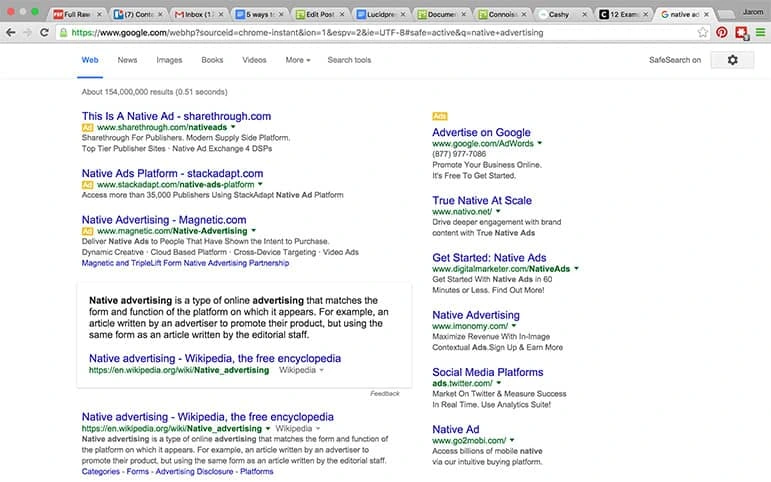
It’s easy to forget that the most common native advertisements are found in every Google search.
Remember this:
- Have a label clarifying that the ad is sponsored content. This solves the ethical dilemma for publishers.
- Make sure the content blends well with your website. This is the crux of native advertising.
- If the brand wants you to publish a story that doesn’t mesh with the character of your website, don’t do it. If you do, loyal readers will call you out as a phony and it will hurt your magazine’s reputation.
- Be creative while looking for native advertising topic ideas. Make sure the content is entertaining or educational.
3. Make an app
Right now, 45 of the top 50 lifestyle iPad apps are magazine brands. This year, the number of mobile-only internet users exceeded the number of desktop-only internet users in the U.S. A native app could add a lot of value for your readers, and if you’re ready to commit to making one, you can make it yourself using a tool like Adobe Digital Publishing Suite or hire someone to do it for you.
That’s a fairly big investment, though. If you’d like to prove out the concept first, you can use Lucidpress to create a digital magazine with interactive content and then publish it on a unique URL with password protection. This way, you can simulate the app experience and see how your readers respond. If it takes off, then you may want to invest in a native app. Remember this:
- Have ads for the app, just like you would for the website.
- Instead of having a paid app, offer a premium account that offers benefits to users.
- Ask for readers to rate and review your app.
4. Become a subscription service
If you become a trusted source for quality content that’s providing a unique perspective, you have a good chance of gaining a loyal following of subscribers. Subscriptions are a particular helpful source of revenue because they are more consistent than a one-time ad deal.
The New Yorker has found success here, attracting a loyal fanbase by consistently putting out fantastic content. Subscribers receive unrestricted access to all the articles and blogs on The New Yorker along with 90 years of archives. Tools like Lucidpress will let you place content behind a subscription paywall. Here’s one simple way to do it:
- Publish your magazine to the web.
- Set a password so only certain people can access the content.
- After readers pay for a subscription, email them the password.
Remember this:
- Price the subscription competitively. Readers expect online subscriptions to be cheaper because there are no printing costs involved.
- Give away a few free articles so that readers can test the waters. Have a plan where readers gain access to, say, 5 free articles in a month. After 5 articles, they will have to pay a subscription fee for unlimited access.
5. Ask for donations
Some magazines depend on the goodwill of their readers to increase revenue. An online tip jar gives readers the chance to contribute to what they consider a worthy cause.
BrainPickings does a great job with this model. It’s a well-designed site that presents quality content for free while asking for donations. Offering incentives for donating can also boost your cash flow. JoshReads and Loading Artist are two websites that provide reader shout-outs for big donors.
The BrainPickings’ appeal for donations.
Remember this:
- Use trusted payment apps like Patreon or PayPal on your website. These apps are designed for this purpose. They are easy to use and familiar to most web users.
- Make the donation button visible on each page. Don’t seem pushy, but write copy that strongly shows why readers should donate.
Ready to get started? Create & customize your own digital magazine with these free magazine templates in Lucidpress.
You don’t need rocket science to see how social media has changed the dynamics of business. It’s almost impossible for a new brand to establish itself without a prominent presence on social media channels. Companies these days use popular platforms like Twitter, Facebook, Instagram, Pinterest and others to boost their online profiles.
Most of us already know how to use these channels, and we see how businesses use them to their advantage to build a strong social media following.
For example, check out this round-up of 10 highly effective social media campaigns.
But there are still effective tactics and strategies that not everyone is aware of, and even now, few brands apply them all to their own online presences. Let’s review a few tried-and-true ways to drive traffic (and leads) with social media marketing.
1. Informative content
We’ve all heard by now that content is the king. We know this in theory, but in practice, it’s more complicated than a simple maxim. Well-crafted content that speaks to a specific target market’s questions and pain points can bring amazing results. A regular cadence of posts will build a bond of trust between a brand and its followers. Interaction through social media also builds that trust, and those long-lasting relationships translate into loyal sales and strong word of mouth better than most mediums.
There are lots of ways to build informative content:
- Case studies
- Ebooks
- Infographics
- Webinars
- White papers
According to research, 78% of customers find custom content useful and believe that companies providing content are interested in building long-term relationships with them. To create amazing social content, search for trending keywords on platforms like BuzzSumo, Social Animal or Sprout Social—then create informative blogs & pages around your findings.
2. Visual appeal
Visitors to a website decide in a split second whether they want to check out the whole thing or leave it. Visual appeal is all about capturing their attention and curiosity, which in turn will improve their engagement and boost the number of pages they visit. These principles apply to social media, too.
There are many ways to add visual appeal to your social content:
- Custom photography
- Artistic designs
- Screenshots
- Infographics
- Data visualization
- Trending memes
As a savvy social brand, it’s up to you to decide how to use these visual assets across the social media channels that would be most effective for your audience. Make sure you understand the culture and purpose of each platform, so that the content type you choose fits the context.
3. Vibrant video
Depending on how a visitor feels in the moment, reading an 800-word blog post might be too much—so they skip it. Alternatively, a strong 20-second video is easily understood and highly effective. That’s why many brands use video to grab attention from social media followers. But know this: the idea, message and execution of the video must work well together, otherwise the effect will be lost.
To make a strong video, create 2 to 3 drafts of the content and ask your team to choose the best one. Then decide where to host the video, keeping in mind that many social platforms (like Facebook) prioritize native video over external links. But, also consider that video-sharing portals like YouTube, Vimeo or Dailymotion can extend your reach.
If you strike gold, your video might even go viral. Just imagine what that could do for your brand!
4. Brand personality
In today’s brand-driven marketplace, it’s all about image and perception. No one stays loyal to a brand simply for the sake of buying a product—the brand’s reputation, the company’s philosophy, and the lifetime value it gives to the customer are all taken into consideration. For a small or medium-sized business, it can be difficult to compete with big, established brands. That’s where the power of social media can make a huge difference.
Quality products and services are vitally important, of course—but the way a company builds its community and nurtures its relationships really does matter. The marketing team must think deeply about the brand’s personality and purpose to achieve brand consistency on social media, which in turn will empower the company to have more meaningful, authentic interactions with its customers.
5. Communication tips
There are a lot of social principles to remember when building a strong online presence. Some can be used across various social channels, and they can be the catalyst a company needs to get the brand up and running.
Here are a few communication tips that can be applied across the board:
- Reply to all comments, quickly if possible.
- If someone shares a complaint, apologize and follow up when the issue is resolved. Visitors can grow angry if their grievances are not addressed in time.
- If someone reports an error or bug, thank them for reporting and investigate the error to resolve it as quickly as possible.
- Approve invitations and friend requests to grow your list of followers (and potential customers).
- Maintain a healthy balance between posting original content and sharing content curated from others. Both serve a valuable purpose in building your brand and attracting followers.
By following these strategies and tactics, you should be well on your way to building a strong, active brand presence on social media—and driving traffic to your site. Give these a try and let us know what’s worked best for you!
Eager to adapt your brand to social media channels? Grab a copy of our free eBook: How to adapt your brand to social media
Whether you’re a recently funded startup or a business that has been operating for years, building brand awareness will always be a top priority.
According to one recent study, 89% of B2B manufacturing marketers said increasing brand awareness was a primary goal for their content marketing tactics—edging out both sales and lead generation.
In startup marketing, in particular, brand awareness is everything. Think about it from the perspective of your reputation: you’re the new kid on the block, entering a crowded marketplace and trying to serve an audience with increasingly fractured attention.
You’ve got to do anything you can to stand out, and marketing is the best way to do it. But in addition to carving out a space in your industry, building brand awareness also brings an additional benefit: anticipation.
People won’t just take your word for it and immediately buy your product or service. They need to be convinced. If you can make them legitimately excited for the idea—if you can start before your product is even released and get them to mark “launch day” on their calendars—you’ll come out all the better for it.
Your brand’s image is long-lasting
Simply put, your brand is your promise. There’s a reason why studies estimate that 45% of a brand’s image can be attributed to not just what it says, but how it chooses to say it.
For a startup, creating an awareness campaign that both a) lets people know you’re coming and b) tells them what you plan to do when you get there checks the boxes of “brand awareness” and “anticipation” at the exact same time.
Remember that your brand is going to outlive whatever your initial offering is. You’re not just trying to sell today’s idea; you’re trying to sell tomorrow’s, too. You need people to stay with you long after they’ve made their first sale, which is why the “brand awareness” side of the coin is so important.
Anticipation builds momentum
To say you’ll be strapped for cash as a startup is quite an understatement. You’re living in a world where every cent counts.
Even so, people are going to need time to discover your product or service. If you wait until launch day to begin this process, you might get where you need to be eventually—but it’s going to take a lot longer. Momentum doesn’t just happen; it needs to build. If you time things right, you can make sure you hit your crescendo on launch day (or as close to it as possible).
Focus on creating visual marketing collateral that doesn’t just “engage” people but actually gets them excited. Build presentations and other visual collateral that contrasts their life before your brand and after it. How will the “after” be better? How will the “after” be easier? These are the questions you need to answer to build excitement.
Think about what you’re trying to do as a Venn diagram. The circle on the left is your product or service. The circle on the right is the daily life of your ideal customer. That space in the middle where the two overlap? That’s the sweet spot you’re trying to fill. If you can find innovative ways to communicate that in the run-up, you’ll make people aware of your brand and get them excited for your launch at the same time.
Guide the court of public opinion
Give your new followers a place where they can discuss what you and they have to say. Whether they’re responding to your launch campaign in a positive or negative way, you need to know what the general response is. Plus, there’s never a better chance to do some course correcting than when you hear feedback straight from the horse’s mouth.
In terms of brand awareness and anticipation, this also creates something of an echo chamber effect. After a certain point, excited customers become brand ambassadors and start spreading your message alongside you. This takes some pressure off your organization while customers do some heavy lifting for you.
Prime your audience
At its core, building brand anticipation is about priming your audience before you launch your business. It’s a strategy with two goals: let people know you exist and tell them how you’re going to change their lives.
Rather than wait until your product/service is absolutely perfect before doing any marketing, you should start thinking (and acting) on this as soon as you can. It’s far better to have a preemptive awareness campaign, even a small one, than to keep everyone in the dark until you’re “ready.”
Why? Because the dirty little secret of entrepreneurship is that you’ll never be ready. Your product or service will never be perfect. To think otherwise is a fool’s errand. Fortune favors those who boldly strike out where others are too scared to try. [![]() ]
]
Instead, start building brand awareness as soon as you can. Today. Right now. Don’t just sell the product—sell the benefits your brand will bring. Then by the time your product is ready, your customers will be, too.
Many of us are familiar with the maxim “Don’t mistake activity for productivity.” It refers to people who juggle multiple tasks, under the guise of staying busy all the time, without ever inching towards their goal. Their time is completely wasted in thinking about what to do next—leaving no time for the actual job at hand.
To bring a renewed sense of productivity to your work life, we offer this list of 7 ways to use your time more wisely.
Related: Productivity tips for businesses
1. Prioritize your projects
Prioritization is not only about completing more tasks within a stipulated time frame; it also refers to eliminating unnecessary tasks. Planning and prioritizing offer clarity of thought when you feel like procrastinating. When backed by strong reasoning, prioritization empowers you to focus on the most important target, while shelving unimportant work for later.
2. Know yourself—and avoid comparing yourself to others
It’s up to each individual to discover their most productive time of the day. For some, early mornings bring a rush of energy, while for others, late evenings prove best for tasks that demand concentration and mental agility. This self-awareness relieves the confusion of how and when to engage in focused work, helping you make the most of your time.
Work as though you’re running your own race. Your thoughts and efforts should be focused on completing the task at hand—not getting bogged down by others’ expectations or worrying about how they will meet their own deadlines. Do away with the urge to seek validation or compare yourself to others, and pour that time and energy back into your own work. The results of your work will be better, and you’ll avoid a lot of unnecessary stress along the way.
3. Make time for your passions
A clear-cut timetable that balances work with play is imperative to striking the right work-life balance. Irrespective of the task, everyone should engage in hobbies and sports occasionally to bring variety, excitement and rejuvenation into their lives. Good hobbies are effective stress-busters, so make space for them in your daily or weekly timetable. Not only does it give you something to look forward to, but you’ll be more relaxed and prepared to tackle the day when you return to work.
4. Unlock the power of saying “No”
Don’t bite off more than you can chew. While proving one’s competence at work is always a concern nagging at even the most accomplished of us, it’s important to be firm in setting realistic boundaries about what you can and can’t deliver. We all have our limits, and if you think you’re going to burnout from work stress, learning to say “No” to extra assignments will save you in the long run. Rather than spreading yourself thin across a variety of projects, you can dedicate yourself to excelling with your most important ones.
5. Resist the urge to multitask
Doing one thing at a time is the secret behind improved productivity. When we’re in a race against the clock, we’re all tempted to indulge in multitasking, hoping to complete several jobs within a stipulated time. But none of us deliver our best work this way. The lack of focus and concentration impairs the quality of our creativity, our decision making, and our results. Errors could even lead to repeat work, which defeats the whole point of saving time in the first place.
If you have several items to focus on within the same day, try segmenting your work time into short, focused bursts. The Pomodoro method is a popular strategy where you spend 25 minutes working and 5 resting. This way, you’re still focusing when it counts, but also giving yourself the freedom to jump between different tasks.
6. Use reminders to stay motivated
The clock is ticking, and with every passing moment, you should be moving closer to meeting your deadlines. When every second counts, it’s critical to stay motivated. Staying motivated will help you push yourself and inspire you to reach ever further to accomplish your goals.
What motivates you? Write it down, and take a moment to review whenever you feel yourself flagging. You might even bring photos to your workplace that remind you of what you’re trying to achieve. Maybe it’s photos of your family, a gorgeous vacation destination, or an aspirational business card. Having a tangible reminder of what motivates you can provide that last burst of energy you need to cross the finish line.
7. Be honest about your progress
Did your work today bring you closer to your goals, or did you just have a busy day? Honest introspection should become a daily practice as you find out which productivity methods work best for you. Take a few moments at the end of each day to meditate on what went well and what didn’t. Consider taking notes so you can tweak your methods as you go along.
There’s much pleasure to be had in this time-bound journey called life, and it’s important to live each moment to the best of your ability. Discipline and repetition form the key to transforming your habits. We hope these tips help you enjoy more productive and fulfilling days.
Want to save even more time? Lucidpress makes it easy to create beautifully branded content in a matter of minutes.
Anyone working in today’s busy world knows just how valuable time can be. Without the right resources and goals, you’ll likely lose time and potential customers. AI is stepping up to provide new ways to get more done during your day. New AI productivity tools can help manage schedules, social media accounts, email, security and more.
If you’re looking to save time, automate busy work, or jumpstart your creativity, take a look at these 7 AI productivity tools that bring a little of the future into your present day.
1. Sidekick
Sidekick is a scheduling tool that helps teams automate their calendars and meeting schedules. When you receive an email with a meeting invite, you can simply forward it to your ‘Sidekick’ who will automatically pencil it into your calendar and send a confirmation to your guest.
You can test out Sidekick for free, or pay $5/month to access team scheduling and other perks.
2. Conversica
If you need help qualifying and following up with sales leads, Conversica is your go-to AI software. This AI initiates conversations with your leads, and when the software thinks a potential sale will happen, it notifies a salesperson so they can jump in and close that deal. By using a number of Large Language Models, Conversica is able to create naturally flowing, human-sounding conversations, so leads don’t even know they’re chatting with a bot.
While you can test a free monthly package that allows you to message 25 leads each month, you might get more out of a paid subscription if you need additional assistance. The Professional Edition plan runs around $3,000 for an annual subscription. Pricing depends on which package you choose. The overall cost may seem expensive, but if qualifying leads eats up a large chunk of your business’s time, the investment may be worth it.
3. Trevor
For task management and personal planning, turn to Trevor. This AI connects your to-do list with your calendar so you can perform certain tasks at the best times for you. You just have to tell Trevor what task you’d like to take care of. Say you’re a Creative Direction struggling with managing multiple projects and deadlines. Trevor’s time blocking feature can help you schedule tasks and assign priorities, helping you visually organize your to-do list to prevent overwhelm
The company currently offers a free and ‘pro’ plan for $3.99/month. With the pro plan, you can sync multiple calendar accounts and task list integrations. Plus, your personal Trevor model will update after each session, slowly personalizing the suggestions it gives you.
4. Ironclad
Ironclad is a handy digital contract management tool that helps you draft, edit, negotiate, search, sign, and store your legal contracts all in one place. With an user-friendly drag and drop interface, you can quickly create and launch contract workflows. What’s more, their “dynamic repository” analyzes your storedrecords, offering real time data that teams can use to work smarter.
While there is no set pricing scale, businesses interested in this tool can reach out to get a custom quote.
5. Frontier Secure
In this age of big-name hacks and cybercrime, online security should always be a top priority for businesses, especially those that deal with sensitive information. Frontier Secure keeps tabs on your computers and data to mitigate corruption, theft and loss. It also offers secure cloud storage to keep your content safe and accessible.
Rather than leaving your sensitive information vulnerable to hackers and would-be thieves, you can use Frontier Secure to back up your data and protect it.
Their base plan starts at $64.99/month.
6. Salesforce Einstein GPT
Salesforce, a popular customer relationship management (CRM) application, gets a futuristic makeover with Einstein GPT. For sales teams, Einstein analyzes leads and determines how likely they are to close. Or, if you work in data, Einstein can automate your dashboards and models. With tools for nearly every department, it’s certainly a powerhouse.
The best part? Einstein GPT is built into many Salesforce products, meaning you won’t have to purchase this AI in addition to other tools. No matter how you use Salesforce, Einstein learns and makes suggestions for your benefit.
If you need another way to connect to your customers, don’t worry. Salesforce offers an array of other AI tools to help you with commerce, marketing, customer service and more. Plans start as low as $25 a month (billed annually).
7. ChatGPT
If you’ve been keeping up with new tech, you’ve definitely heard of ChatGPT and its sibling GPT-4. These AI tools have completely changed the marketing game, allowing anyone to create written content and generate ideas. With its ability to scrape all corners of the web, these tools can help users solve complex problems in seconds, opening up new opportunities for team efficiency.
Currently, a subscription to Chat GPT Plus will only set you back $20 a month. However, you can also use this AI tool for free.
Bonus: Marq
As commerce moves from product centricity to customer centricity, it’s incredibly important to build and protect your brand. A strong brand leads to stronger relationships with customers, leads, and the public at large. And, as we know from our research, it leads to stronger bottom lines.
For this reason, enforcing brand consistency across your organization is vital to its growth. But how do you prevent rogue, off-brand content from sneaking through sales teams, people operations, and all the other departments that generate content?
Marq streamlines brand consistency by baking it into the content creation process. When you create documents in our platform, they’re housed in a central location with advanced sharing & editing permissions. All the brand assets you need (logos, colors, fonts, etc.) are accessible from right inside the editor, so no one has to track down the latest approved versions. Plus, you can lock down parts of your documents to prevent future changes—no deleting, moving, hiding or stretching. It’s the simplest way to ensure that your organization’s content is beautifully branded.
Marq offers several pricing options depending on the size of your team and the features you need. However, if you want to give it a test drive, it’s easy to sign up for a free account. You can create documents from scratch or start with one of our hundreds of customizable templates.
Ready to save more time? Marq makes it easy to create beautifully branded content in a matter of minutes.
On average, people who live near big cities spend nearly two hours each day commuting to work and back. This adds up to more than 500 hours—or around 21 days—per year! [![]() ] That means most of us spend up to three weeks of our year on commuting to and from work. Geez.
] That means most of us spend up to three weeks of our year on commuting to and from work. Geez.
Related: 9 tips to master your morning routine
However, it doesn’t all have to be lost time. You can use your morning and evening commutes to add a little something extra to your day. Here are 10 practical ways to make your commute a productive one.
(Of course, some of these will depend on your form of transportation. If you’re a passenger in a vehicle or on a train, you have more options. If not, use your best judgment and always drive responsibly.)
10. Listening to audiobooks or podcasts
Commuting gives you more time to learn new things about all sorts of topics. First, you can listen to work-related podcasts to hear about the latest industry trends. If that’s not your bag, listening to audiobooks is also a very pleasant way to make use of the time. There are many online audiobook libraries where you can find thousands of interesting titles. If you can’t seem to make room for books during the day, this is a great way to blast through your reading list.
9. Read company news
Company news is usually valuable info, but few of us pause to read the updates during busy office hours. Still, those announcements could help you discover and appreciate new developments in your organization. Take some time while commuting to review the corporate blog and social media profiles. It can reveal valuable knowledge that will help you stand out from the rest of your colleagues and feel more connected to your workplace.
8. Plan out your day
You probably don’t start a single project without a decent plan, and there’s no better opportunity to set your daily schedule than while you’re riding public transportation. You can use a mobile notepad to create your plan, then stick to the scheduled activities to increase your everyday efficiency.
7. Check your email & compose drafts
We usually check our emails throughout the day as we complete more important tasks. However, commuting gives you the chance to start your workday a bit earlier. You can check your emails while traveling and save regular business hours for serious work. For an even bigger boost, you can compose draft replies to the most important messages then send them when you get to the office.
6. Learn a language
Learning new languages can truly enrich your understanding of the world. If you’d like to get started, choose a language that suits your personal interests, whether it’s a place you’d like to visit one day or a language spoken by people you know. You can also study a language that improves your career prospects. Whichever way you choose to go, there are more than enough high-quality language learning apps to help you build fluency.
5. Brainstorm problem solutions
Most likely, you have to deal with numerous problems in your job. Coming up with the best solutions can be demanding and time-consuming, and the stress can dampen your creativity. Your old familiar commute gives your brain a chance to relax and come up with creative ideas. Without disturbances from your colleagues, you can have a few moments to ruminate on the biggest problem you want to solve that day.
4. Practice meditation
Meditation has gained popularity recently due to its various health benefits. It can help you relax and set your mind free from everyday stress. Plus, there are lots of apps and videos that provide guided meditation and soundscapes. The biggest challenge for commuters here is to ignore all the surrounding noise. But, as you keep practicing, you will soon find that you can meditate in any environment, regardless of external distractions.
3. Listen to music
Music has the power to inspire you in the morning and help you relax at night. We all have our favorite songs and artists, so of course, build yourself a playlist based on personal preferences. Additionally, I suggest that you try some chill-out music such as classical, lounge, or even lo-fi hip-hop. Using mobile radio apps, you can get a wide variety of free music channels. It’s the perfect way to add a little culture to your commuting hours.
2. Make a list of your goals
Who says that daydreaming is always bad? If you have big dreams about your career or personal life but never enough time to think about them, take the first step by creating a list of your goals. It’s a well-known fact that people who write down their objectives have a much higher chance of achieving them. Give it a try, and let your goals motivate you as you move through the day.
1. Record your achievements
Not only should you create a list of your goals, you should also keep track of your achievements. This is important for boosting both motivation and confidence. Seeing your progress will make you proud and eager to carry on. It also gives you a good recap to share with your manager whenever you discuss your performance and career aspirations.
Commuting to work every day isn’t always easy or fun. We all spend a lot of time traveling, so it’s worth it to find a way to use it productively. Try some of these ideas and see how it improves your productivity and the quality of your day.
Finding the right real estate marketing agency is often compared to finding the perfect date. If you discover that an agency doesn’t meet your standards or help to grow your business, then you’ll be traversing rocky roads until you tell them to hit the trail. However, if they enhance your marketing efforts and drive results, then it will be a successful, happy relationship.
Related: Real estate marketing tips and tools
Just like any good advice column, we went straight to the experts and asked them: When is the right time to hire a real estate marketing firm? What should you ask for, and what should you watch out for? Here’s what they told us.
When to hire a real estate marketing agency
Hiring a marketing agency can be expensive but well worth it—if you find the right one. But when is the right time to start looking for an agency to take over your marketing? If you’ve just started your company, it isn’t yet time to worry about this, but it might come up later on. For example, here are some of the reasons our experts gave.
- Looking to grow. If your company’s growth is stalling, or if you’re reaching your goals but want to accelerate, it might be time to consider hiring a real estate marketing firm. The agency can take some responsibilities off your plate and super-charge your marketing efforts.
- Lacking the time or skills. Alen Kadimyan, CEO of IEI Realty, said they knew it was time to hire an agency when they ran out of time to increase their marketing efforts. “We were falling behind on social media marketing, SEO, and our presence was not as prominent. We needed to differentiate ourselves from other bus-bench agencies.” Bringing in an agency can fill those time and skill gaps for you.

- Unsure of your next move. Here’s the situation: You’re running all the marketing yourself, or you have some in-house marketers on hand. However, you’re struggling to determine or settle on a larger marketing strategy. This is a clue to begin searching for a real estate marketing firm that can help you find your direction.
What to look for in a real estate marketing agency
Benjamin Franklin often advised others to date “with your eyes wide open,” to ensure you don’t go into a relationship blind. This advice applies well to finding the right marketing agency for your real estate brand. Here’s what our experts say to watch for when you’re “courting” a marketing firm.
Do they provide the services you need?
Before searching for real estate marketing services, you should sit down with your team (no matter its size) and discuss which services your brand would benefit from most. This could be digital marketing, PPC, social media, creative strategy, advertising, or any number of services. Once you understand your priorities, you can start looking for creative marketing firms who are experts in those areas.
Kadimyan said that when they began searching for marketing services, they knew exactly what they needed help with. “We needed someone who could help us find a unique voice in our branding, help us market ourselves as millennial-friendly realtors, and help us expand our reach on social media.” These goals made it easy to narrow down their shortlist to the firms who specialized in those areas.
Do they understand real estate?
It’s vital for agencies to know how real estate groups work and how to collaborate with them, according to Kadimyan. “Make sure they understand real estate, selling and buying process, and are familiar with the terminology. Agencies that stay connected via messenger and accommodate the on-the go agency.”

Jeff Miller, a real estate broker with AE Home Group in Maryland, said that marketing agencies who try to be experts at everything only end up being average in their skills. “We found that it is much more effective to hire an agency based on their expertise in one vertical of marketing. Our experience was that being great at one form of marketing yields more leads than being average at all of them. Over time, if we want to expand and obtain more leads, then we would reassess hiring additional agencies who are experts in other verticals.”
Do they understand marketing trends?
A good marketing agency is on top of the latest trends in digital marketing and traditional advertising. They should be able to tell you which mediums, channels and formats are most effective today—and which ones should be left by the wayside. Perhaps most importantly, they should be able to spot opportunities that other marketers are missing.

Evan Roberts, a real estate agent with Dependable Homebuyers, said, “A good marketing agency should be able to guide you on whether direct mail, Google Adwords, Facebook marketing, or print ads are providing a high return, and which calls-to-action are connecting with individuals in your local city. Marketing agencies create their value by saving you money in pursuing strategies that others have found to be ineffective.”
Do they have experience in your area?
Local marketing is big business, but few industries depend on it as much as real estate. Understanding the local areas you serve is business-critical—without that knowledge, your failure is virtually assured. Your marketing efforts should cater to local areas and help you build relationships with local homebuyers and property owners. Therefore, your agency needs to research and immerse themselves in the markets you serve.
Regarding experience in your locality, Roberts said, “As a real estate brokerage, it is critical that your marketing agency have extensive experience in your local area. Every major metropolitan behaves differently. Some tactics work great in some areas while being over-saturated in others.”
Do they share your vision?
You’ve created a vision for your real estate brand. If you want to see your vision come true, then your marketing agency has to understand and support it. The agency you hire will create strategies that impact your brand and business, so you want to make sure they’re on the same page as you.
Your brand’s vision and values should come across in your marketing, from creative advertising to social media to direct mail campaigns. When you find an agency that shares and respects your values, their work for you will reflect that in a compelling, natural way.
Do they play to your unique strengths?
What unique advantages do you already bring to the table?
Most realtors are warm and personable. But you might be a uniquely good writer, photographer, or great in front of a camera. Handling certain tasks yourself lets you play to your strengths and ensure your brand conveys a personal touch.
Real estate is a face-to-face, high-trust industry. It’s important your marketing conveys a personal feel. One potential solution is to focus on tactics that tap into your strengths and hire out the rest piecemeal.
For this to work, your marketing partner must be flexible with their services offered. Don’t get locked into a contract where you’re paying for things you could have done better yourself.
Do they have simple (and transparent) metrics?
Terms like “increased brand exposure” or “better visibility” sound great… but only if they translate into a healthier pipeline of leads and clients. What can’t be measured can’t be improved.
You might not understand all the technologies or tactics a marketing agency might use, but tracking results should be simple. Look for partners with a regular reporting deliverable, or at least access to a dashboard that helps you see new contacts being made and how well they’re responding.
Don’t buy into one of those promised “hands-off” solutions. At a minimum, you’ll want to check the metrics to make sure your investment is justified.
Making the best decision for you
Between all those open houses, impromptu photo shoots and stressful closings, you can’t let marketing fall by the wayside.
Whether you decide to hire a marketing agency or handle it yourself is a personal decision. It also isn’t a completely binary one. You might find that, after experimenting for a few months, a balanced solution—where you handle the parts of marketing you enjoy and hire out the rest—works best.
Bonus: Real estate marketing company comparison chart
When you start looking for real estate marketing firms, it’s easy to run into information overload. To help you get started, here is a comparison of some of the top real estate marketing firms. The chart includes services offered by NYRE, SM Sold, Conway + Partners, Cohn Marketing and 3 Sixty Strategies. Find your perfect combination of SEO, social media and website creation services.
View and download this table here.
You can use this as inspiration to create your own comparison chart in Lucidpress, Google Docs or Excel. This will help you keep track of the different marketing agencies you research, so it’s easier to make your final decision.
Your brand matters. Learn how to protect and elevate your real estate brand in this branding essentials guidebook.
If your real estate business is growing, it’s only a matter of time before you’ll need to reevaluate your marketing strategy. “Growing pains” are definitely real, and your agents will feel the squeeze as you try to scale your marketing efforts for larger audiences.
Related: Should you hire a real estate marketing agency?
When you find yourself at this point, it’s time to automate. Real estate marketing automation software will save agents time and help you reach and nurture leads more effectively. It handles many complex tasks that are either too difficult or time-consuming to do on your own. But like any software, it comes with serious considerations, such as cost and learning curve.
In this post, let’s go over what marketing automation is, how it can help your real estate business, and how to choose the right software for your brand.
What is marketing automation?
Marketing automation is the process of automating certain repetitive marketing tasks. It’s designed to support multiple channels, so your marketing efforts (and your brand) stay consistent across the board. Most marketing automation platforms support websites, emails, and social media.
Marketing automation use cases
Let’s go over a few examples. Here are some of the ways agents can use marketing automation software to work more efficiently.
Reduce cart abandonment. Imagine you sell products on your website. It could be branded merchandise, online courses, or real estate services.
Ideally, when someone adds an item to their cart, they will complete the transaction immediately—but, that’s not always the case. They may have been looking for more information, like shipping prices, before making their decision. Or, maybe they realized they can’t afford to pay today.
Either way, the result is an abandoned cart and lost sales.
Marketing automation software can help you capture this information and add this lead to your database. Then, you can target this lead with a follow-up email that encourages them to return to their cart and finish the sale. You could provide them with a discount, free shipping, or some other enticing offer. This email could be the key to persuading the buyer to complete the sale.
Nurture your blog subscribers. If you’re investing time and resources into content marketing, your goal is to engage an audience who may not be ready to buy today, but they will be in the future. Maintaining an active blog is a popular way to build an engaged audience of subscribers.
So, how do you move these people toward sales?
Real estate marketing automation can help agents set up email campaigns to nurture those blog subscribers. You can even divide your audience into segments and send them relevant, customized content—like local listings. Regular contact will keep your brand top-of-mind, so they think of you first when they need an agent.
Identify leads who are ready to buy. Sometimes, it’s hard to track all the leads in your system and prioritize the ones most ready to buy. You don’t want to miss a sales opportunity while it’s hot, so you decide to prioritize leads who’ve completed certain actions on your website.
But… which activities should you track, and how?
A good marketing automation program will provide reliable data on the actions that demonstrate high interest:
- Landing page visits (such as visiting your pricing page more than once)
- Email opens (like opening a demo email, but not clicking through)
- Lead scoring (assigning a number to a lead based on how many actions they’ve completed)
Based on this information, you can be confident that you’re reaching out to a real estate lead at the right time.
Benefits of marketing automation
Now that you understand what real estate marketing automation is and how it can be used, let’s review the benefits.
Marketing automation software saves time. Creating customized campaigns won’t take as long as it used to. Because your agents don’t have to spend time performing repetitive marketing tasks, they have more time to spend face-to-face with clients—closing more sales.
It makes your advertising more effective. Because marketing automation software uses data to make decisions, you can be more confident that your message is reaching the right people at the right time. From email automation to SMS messaging and mobile push notifications, this software streamlines a variety of marketing techniques, so agents can focus on getting the best results from each.
It makes marketing management easier. Before automation software, agents had to spend hours every week performing repetitive tasks and sifting through the data—introducing many chances for error. Now, a program can manage these things for you, and all you have to do is maintain and optimize your campaigns.
Lead gen best practices
If you’re interested in marketing automation for real estate, you’re probably already generating a fair number of leads. If not, you might want to get your lead generation efforts up and running first, so you can get the most out of your real estate automation software.
In either case, it’s never a bad idea to review lead gen best practices. What makes a good lead generating strategy?
Move leads down the funnel. Remember the classic customer conversion funnel? It describes the journey a buyer makes through the stages of awareness, interest, desire and action. For each stage in this funnel, you should have landing pages and content to match. For example:
When you have all these pieces in place—and you use clear calls-to-action to connect them—buyers will move seamlessly through the stages with fewer obstacles and objections. Marketing automation software can help you manage and deliver that content, so your leads don’t get lost or go cold.
Build your own email list. If you’re just starting out, it’s tempting to purchase email lists. But when you buy a list of addresses, you’re getting the same tired list that many other agents have used before you. Bottom line—it will never be as effective as the list you build yourself.
Make it easy for people to subscribe to your blog and email newsletters. Put sign-up links on your website, blog and social media channels. Collect email addresses from clients and prospects you interact with, then add them to your email list. Offer incentives to sign up for your email (e.g. coupons, sweepstakes, listings info), and remind people about it both online and offline.
Because this list is targeted and unique to you, you’ll enjoy better open rates, click-through rates, and conversion rates.
Maintain brand consistency. It’s often said that a prospect requires 6 to 8 “touches” from your brand before they become a lead. These touches can come in the form of advertisements, listings, webpages, emails and social media posts—all different channels.
If your brand identity & messaging aren’t consistent, you risk losing and confusing your audience. That’s why brand management is so important. Make sure agents are all using the same brand assets (colors, logos, fonts) and messaging (voice, tone, offers). The consistency will help buyers recognize, remember and trust your brand.
Related: The complete real estate marketing guide
Which software do you need?
To figure out which real estate marketing automation software to use, you have to ask yourself a few questions. The answers will provide a rubric for evaluating all the options out there.
Am I using inbound or outbound marketing? Generally speaking, there are two types of marketing: inbound and outbound.
You can think of outbound as “push marketing,” where you push a message out into the world (e.g. advertisements) in hopes of attracting the right people to your brand. Outbound marketing includes:
- Print & broadcast advertisements
- Direct mail
- Paid social ads
- Paid search & display ads
Conversely, you can think of inbound as “pull marketing,” where you publish and distribute messages (e.g. web content) that interested buyers search for online. Inbound marketing includes:
- Blogging
- Organic social media
- Organic search
- Emails to your list
Which strategy do you use most often? In reality, most real estate brands will use a mixture of both. Outbound marketing is good for building initial brand awareness. Inbound marketing is good for driving qualified leads. Both can contribute to a healthy sales pipeline.
Determining what type of marketing you use the most can help you prioritize which automation software to consider. Some specialize in one or the other, and some cover both.
Which channels do I use (or want to use)? This question dives a little deeper than the last. Rather than thinking in broad categories, get specific about the marketing channels you want to automate.
Different software will specialize in different channels. Make a list of the channels that are “must-haves” and “nice-to-haves.” Your lists could include:
- Website actions
- Social media
- Content publishing
- SMS messaging
- Mobile push notifications
As you can see, the potential of real estate marketing automation goes far beyond email. But, not every agent will need all the bells and whistles. As management, it’s up to you to decide which features are most relevant for your agents. Then you can filter out the software that doesn’t meet your needs—or, perhaps, far exceeds them.
What tools do I need to integrate with? Chances are, you’re already using a slew of programs to manage your business. Marketing automation could replace some of those, but of course, not all. It’s important that your marketing automation software plays nicely with the other tools you’re using.
Linking your marketing automation software to other tools will increase its usefulness. They provide useful data your software can use to make decisions.
Examples of tools you could link to your marketing automation software:
- Salesforce (CRM)
- Microsoft Dynamic (CRM)
- Google Analytics (data)
- Kissmetrics (data)
- Facebook (social)
- LinkedIn (social)
- Eventbrite (events)
There are thousands of examples (just glance at Hubspot’s integrations page to get an idea!). Take a close look at which tools you could replace with marketing automation and which tools you’d need to integrate.
Related: Real estate marketing software that outperforms competitors like Imprev
Important evaluation criteria
It’s not just the software that you’re evaluating—there are other reasons to choose one program over another. Here are a couple of additional considerations.
Implementation and ramp-up. Setting up a new software is not an easy task, especially one as complex as marketing automation software. (Switching from one software to another can be even harder, as we learned here at Lucidpress when we switched from Hubspot to Marketo.)
Make sure you have a plan and a timeline for implementing the new software: importing data, connecting tools, adjusting code, and setting up initial campaigns.
Also think about the ramp-up. Which campaigns are absolutely necessary to get started? Which ones can you hold off or pause while you get up to speed?
There’s also adoption: Who needs to learn and use this software regularly? Make sure you have any training resources you need, and that all agents are on the same page.
Service and support. If something breaks or doesn’t work, who do you call? If you’re comfortable troubleshooting yourself—or if you have an IT person—you might not need additional support from your marketing automation provider.
But if you’re not, it’s worth asking about services and support. What’s included in your subscription? If your agents need more help or training, is there an extra cost associated with that? How responsive is their team? You can include all of these in your evaluation.
Marketing automation comparison chart
Now that you know what marketing automation is and how it could help grow your real estate business, it’s time to start evaluating providers. We’ve chosen a handful of software programs that are popular with real estate brands and compared them below.

View and download this table here.
To find out more about the 7 programs in our chart, visit their websites:
You can use this as inspiration to create your own comparison chart in Lucidpress, Google Docs or Excel. This will help you keep track of the marketing automation software you research, so it’s easier to make your final decision.
Your brand matters. Learn how to protect and elevate your real estate brand in this branding essentials guidebook.
When we consider brand-customer relationships and interactions, many of us instantly think of viral examples of “brands behaving badly”—like a tweet about a lost online order or a post about terrible airline service. And then there’s the aftermath of such an interaction, where the brand scrambles to do damage control by pledging to do better next time and make changes going forward.
Related: 5 situations that can damage your brand—and how to respond
But, what if there was a way companies and brands could respond to every customer in real time with a completely personalized approach? There is a new way of cultivating and maintaining customer relationships. It’s faster, easier and cheaper than any call center.
Enter chatbots
First, what are chatbots? Chatbots complete automated tasks and services via messaging apps. They also respond to users by pulling answers from a database and relying on pre-programmed phrases. Some bots employ artificial intelligence (AI) to learn and get “smarter” with each interaction, like voice assistants Siri and Alexa.
Because of their ability to interact and provide instant answers to users’ questions, bots are uniquely suited for improving customer service. Here are just a few ways chatbots can benefit brands.
Chatbots are available 24/7/365
Thanks to apps like Lyft and Uber Eats, our society has become even more accustomed to instant gratification. We want everything right here and now; it’s the definition of the on-demand economy that apps and bots helped to create. So, it makes sense that bots would step in to fulfill our need for immediate interaction with brands and companies.
Protecting your brand’s reputation for stellar customer service could be as simple as deploying an after-hours chatbot for your website. Long after your human customer service reps have clocked out and gone home, your bot is hard at work fielding questions from customers.
Additionally, since bots are designed to complete tasks and gather information, brands are positioned to solve some of their unique customer service challenges with the implementation of chatbots.
One thing to note: Be upfront when customers are communicating with a bot. In other words, don’t disguise the chatbot as a real person. In fact, bots are favored over humans when it comes to answering quick questions. So, let customers know that after-hours customer service is handled by chatbots.
Chatbots are proactive
Browse through any e-commerce website, and you’re likely to encounter a bot in the form of a helpful personal shopper. More brands are using chatbots to interact with customers and establish contact proactively in anticipation of shopper needs.
Why the shift? A recent poll found a whopping 83% of shoppers say they need help while shopping online. The thought behind this strategy is that not connecting with a shopper until they actively reach out with a question often results in the loss of a sale. But, if a brand can reach out and start a conversation with a customer at the beginning of their shopping experience, there’s a better chance of keeping them on the website.
Brands like Aerie and Whole Foods are using chatbots exceptionally well to proactively engage with customers and offer things like discounts and recipes.
Think of all the possible ways a bot could help a browsing customer before they even know they need help:
- Advising on size, fit & color
- Answering FAQs faster
- Fulfilling inventory checks
- Assisting with account questions
- Facilitating returns or exchanges
Chatbots are more consistent, faster & cheaper
Humans get burnt out, have bad days, and need to take breaks. Bots have no such problems. Bots can work around the clock and never waiver in the level of customer service they provide. Humans have a limit to how many people they can realistically help during a shift, while bots are not beholden to any such rules. Because bots are inherently adaptive and exist solely to help users, they can even build relationships more efficiently than humans. (That is, to a degree.)
Chatbots are great at collecting data from their interactions with customers, which can then be used to improve or personalize future communication. Instead of a customer starting over each time they visit your site, a bot can pick up right where they left off and build upon the previously established relationship.
Bots can handle tedious tasks (like gathering and verifying account information) much faster than a human employee, and they do it all without the need for a paycheck. Plus, the overhead required to staff a 24-hour call center far outweighs the cost of programming a chatbot.
What’s next?
Humans will never be fully replaced by chatbots for meaningful interaction, especially in face-to-face instances. But, as engineers fine-tune their programming to become more sophisticated and handle increasingly complex requests, more brands will use chatbots as a way to stay “always on.”
Every business owners’ hope is that their business will grow. Whether it’s a small, medium or large business, there’s always room for growth. It’s an exciting process, but it might be short-lived if you’re unable to manage your brand consistently.
Related: Brand consistency—the competitive advantage and how to achieve it
As you add more people to your team and start producing more content (such as landing pages, social media posts and ads), how do you keep everyone on the same page? How do you maintain brand consistency to keep your brand’s message clear and strong?
Here are five tips on how to do just that.
1. Create a brand style guide
With more employees and less time to look over every piece of content, it’s difficult to catch off-brand materials before they go out.
Create a brand style guide that shows employees how to use your branding properly. This will help your employees create on-brand content that shares a consistent look and feel.
Your brand is more than just the logo and colors that you use, so naturally, your brand style guide will cover more ground than that. Here’s a list of useful sections to include.
Mission
What does your company do? Lay the foundation for your style guide by first addressing your company’s goals and what you hope to accomplish in the future.
If you haven’t written a mission statement or want to spice yours up, here are some powerful examples.
- Patagonia: “Build the best product, cause no unnecessary harm, use business to inspire and implement solutions to the environmental crisis.”
- Walmart: “Saving people money so they can live better.”
- Wendy’s: “To deliver superior quality products and services for our customers and communities through leadership, innovation and partnerships.”
Target audience
Discuss who your target audience is. What’s most important to them, and why do they use your product? This will help your employees better understand who they’re talking to and why it’s important to communicate with your audience in a consistent way.
Values
When someone reads through your brand style guide, they should be able to relate to your brand and anticipate how your brand will respond in certain situations. This is why it’s important to have a section dedicated to the values of the company.
What values must come first in your company? By including these, your employees will know how to communicate with your customers.
Brand personality
Your brand personality comprises the characteristics you use to describe it. If your brand was a person, what would they be like? Professional, witty, funny?
If you’re struggling to think of characteristics that describe your company, survey your customers and ask them what personality traits they feel your brand has.
This helps bring your brand to life and give better depth to your brand’s voice, tone, messaging, and even its visual elements.
Visual elements
This section is where you put all the specifics regarding your logo, colors, typography and imagery. Provide as much direction with these elements as possible. For example, show each version of your company’s logo and describe how it should be used, where it should be located, when to use certain colors, etc.
For more help in setting up your brand style guide, check out our post on great examples of brand guidelines. You can also look at this 99designs blog post that goes into more detail about brand guidelines.
2. Pay attention to messaging & tone
Communicating with customers is often achieved through writing. Text appears on your advertisements, in your product, in blog posts and on your website—just to name a few examples.
Imagine how confusing it would be if you had a friend who always spoke with a Midwestern accent, but then one day, they showed up talking like a Californian surfer or a seasoned New Yorker? All of these accents are great, but you’d be pretty confused about what was going on with your friend. Could you even trust them anymore?
This is why consistent messaging is important for your customers. If the writing on your website uses a formal tone, but they receive emails from you that sound like a casual conversation, they’ll be wary—and rightfully so.
While creating your brand style guide, focus on describing your company’s tone and provide writing examples that fit your company’s voice.
When you read what other employees have written, give specific feedback about what is on-brand and what is not. Over time, they’ll learn which words, phrases and punctuation are appropriate for the brand.
3. Regularly train your team
Now that you have a brand guide for your employees, show them how to use it. If you don’t, your brand style guide will likely end up being ignored. If you can get your employees excited about your brand, they’ll be inspired to represent it well by following your style guide.
The opposite is also true. If you fail to get your employees onboard with your branding efforts, they may reject these new “restrictions.” This will promote more inconsistency and upset employees.
Keeping your brand consistent is a team effort that requires everyone to be onboard. Prepare an engaging presentation to introduce the brand style guide and strategy. Listen to their feedback, but make sure everyone understands the importance of consistency.
There might be a need for additional training for employees who are more involved in branding efforts such as writers, designers, marketers, customer service reps and managers. Once these employees are ready to build up your brand, ask them to share the same training with new employees as they onboard.
Keep an eye on the enthusiasm surrounding your brand. As it fades, you’ll have to recalibrate with reminders and additional training. It’s important for employees to know that you will champion the brand over the long term.
Key takeaway
When you focus on building a brand, the most important thing is to commit to it. No matter how well thought-out your brand is or how clever your messaging is, if it’s inconsistent, consumers will lose trust in you.
Create your brand guidelines, train your employees, find the right messaging and stick to it. The best companies in the world have championed their brands for decades. This consistency is part of their success—they’ve become familiar, beloved names for millions of customers. Lay the foundation for your brand today, so it can reap the benefits for years to come.
Want to know more about the impact of brand consistency? Download our free 32-page report, chock full of stats & great insights.
Do you struggle to manage your real estate brokerage? I don’t blame you—your list of tasks can feel overwhelming. With tracking leads, managing commissions and uploading new listings, there’s a lot that goes into selling properties.
But, there’s one thing that can help: Software.
Related: Should you hire a real estate marketing agency?
If you’re enlisting the help of real estate software to help you manage each task, you could cut the time you spend on each activity—and boost your productivity in the meantime.
In this guide, we’re sharing a list of 12 incredible real estate softwares you can use for each major task you’re handling on a daily basis.
1. Copper CRM
Is your inbox out of control? Whether you’re inviting leads to an open house event or coordinating with someone selling their home, you might be struggling to remember who’s who.
That’s where Copper (formerly ProsperWorks) helps.
Because Copper is a CRM with G Suite integration, you can create profiles for each person you’re emailing—allowing you to follow email conversations and manage leads directly from your inbox, without needing to switch between several apps.
Pricing: From $19 per month.
2. Propertybase
If you need more from your CRM, Propertybase is worth investigating.
This real estate software tracks and manages leads, while also featuring a marketing center to manage email campaigns, real-time lead generation dashboards—and even syndications with platforms like Rightmove and Zoopla.
Granted, it’s more expensive than Copper’s CRM, but it could be the only software you need to manage your brokerage.
Pricing: From $79 per user, per month.
3. QuickBooks
QuickBooks is an accounting tool that real estate companies can use to track their finances. But, what makes QuickBooks different is the control it gives businesses without tons of financial knowledge, looking for more than just a spreadsheet.
You can track transactions, along with:
- Property descriptions—including floor plans
- Lease dates
- Current and market rent
- Due dates
- Appraisal values
Pricing: From $10 per month.
4. Placester
Every brokerage needs a website—that’s nothing new. But if you’re looking for a platform built specifically for realtors, Placester is fantastic.
Placester allows you to build modern, personalized websites with the aim of generating more leads for your properties. And, with several themes and lead capture templates to choose from, you don’t need a ton of HTML knowledge to create a strong website for your real estate company.

Pricing: From $99/month, plus $99 setup fee.
5. PropertyWare
Are you managing a handful of rental properties at your brokerage? Another real estate software you should add to your list is PropertyWare.
Designed to act as a “toolbox for single-family property management,” PropertyWare is a web-based software that allows realtors to track payments, create online portals for tenants and owners, and screens tenants to make sure they’re high quality.
The best part? It’s built by property managers—so they know what they’re doing.
Pricing: From $1 per unit, per month (minimum 250 units), plus an implementation fee of 2x the monthly subscription.
6. Commission Trac
Creating commission reports can quickly get confusing. That’s where Commission Trac shines.
A real estate platform that allows brokers to manage commission plans, invoices and agent distributions, Commission Trac “streamline back office accounting” and take away the headache from managing commission cuts.
They’ve also partnered with organizations like the National Association of Realtors to offer members 20% off their plans.
Pricing: From $45 per month, depending on how many agents are in your brokerage.
7. HelloSign
Don’t let paper documents take over your office. Ditch the traditional scanners and use HelloSign instead—a tool that allows your clients or tenants to sign documents electronically.
You can use HelloSign for a variety of electronic documents, including:
- Tenancy agreements
- Mortgage papers
- Offers to purchase
- Closing statements
- Real estate transfer tax returns
Plus, HelloSign documents are legally binding (and enforceable in court).
Pricing: Free for 3 documents per month; $13 per month thereafter.
8. ShowingTime
If you regularly schedule property viewings, ShowingTime is a software you’ll love.
ShowingTime is a real estate software that allows brokers to collect analytics and provide feedback on home showings. It also allows realtors to quickly schedule and confirm property showings, while helping to offer better customer service to their clients.
Nobody likes no-shows, right?
Pricing: Custom; demo required.
9. CityBlast
You’re likely familiar with marketing software that can help businesses supercharge their growth.
But, CityBlast is different to the rest. They focus solely on real estate businesses and have a live team who describe themselves as “social experts.”
They provide social media PPC campaigns to increase audience growth—meaning you could see more social followers, site traffic and hot leads if you’re enlisting their specialist help.
Pricing: From $83.25 per month.
10. AreaPulse
For more in-depth reports on your properties, it’s worth checking out AreaPulse.
In this web-based real estate software, you’ll find every metric you need to track the success of your brokerage, including:
- How long a property has been on the market
- 6-month price trends in the local area
- How many homes you’ve got for sale
You’re also able to send AreaPulse reports to your potential customers, giving them a solid understanding of the property market. Plus, with the ability to track open rates on these emails, it’s a great way to identify which subscribers could become hot leads.
Pricing: From $49 per user, per month.
11. HouseCanary Value Report
Another incredible option if you’re looking to dive deeper into real estate analytics is HouseCanary’s Value Report tool.
They use data science, advanced software and predictive analytics to create the “most accurate automated valuation model”—meaning you get a full understanding of the local property market, forecast returns over the next three years, and set rent fees that are relative to the area.
Sounds awesome, right? (Spoiler alert: It is.)
Pricing: Custom.
12. Lucidpress
…We couldn’t share a list of real estate softwares without including ourselves, right?
Lucidpress gives brokers a nifty tool to create branded real estate marketing material—such as PDFs, social media images and newsletters—in one web-based portal.
There are hundreds of templates to choose from, making it perfect for real estate businesses that need ahold of their branding campaigns, but don’t have a clue about graphic design.
(Considering that consistent branding increases revenue by 23% on average, you’d be mad to miss this off your list.)
Pricing: From $5.95 per month.
Key takeaway
Now that you’re well-equipped with the real estate software you’ll need to manage your brokerage, it’s time to start seeing results.
Remember to determine which tools are affordable, and start with tools you need (versus the tools you want). You don’t want to go broke in the process.
You’ll soon be experiencing increased productivity—we’re sure of it.
Get started with Lucidpress, the brand management platform for real estate. It’s perfect for brokerages of any size.
Building out a successful brand doesn’t hinge on offering a great product or service alone. You also need smooth, efficient operations that are consistent from location to location.
The most popular restaurant chains, for example, draw customers in everywhere because food quality and service quality are consistent across the board. People know what they are going to get and there’s comfort in that knowledge.
Related: 7 tips to coordinate local & national franchise marketing
Finding the best franchise management software tailored to the needs of your business is critical to its overall success. It will streamline day-to-day operations and keep everything from distribution to accounting running like a new high-powered engine.
Here’s a look at four examples of franchise management software designed to boost your brand.
Naranga
This versatile cloud and mobile platform is designed to streamline and automate both sales and operations. It’s used by more than 300 brands nationwide, and it handles a wide spectrum of needs for any franchise owner.
Naranga assists with key functions needed to run day-to-day operations. It can be used to train employees, streamline communications, onboard new franchisees, conduct mobile field audits, organize local marketing efforts, and turn leads into sales. (Phew, what a list!) It features tools like commissions manager to construction tracker to help franchise owners stay on top of daily operations in all franchise locations.
Marketing 360
Advertising is the lifeblood of any brand. You can’t get customers without getting the word out first. Marketing 360 makes marketing so much easier to manage, so you direct your time and money down the avenues that are most effective.
What sets Marketing 360 apart? It makes point-of-sale (POS) marketing a breeze. This platform features tools that track organic search results through keyword volume and ranking, analyze SEO performance for competitors through those same keywords, and segment and target ads to a specific demographic. Users can create branded webpages that include call-to-action buttons. The platform also makes it easy to customize and edit website templates.
Vonigo
This cloud-based platform sets the standard for service-based franchise software. It’s available with a monthly subscription that includes phone support and product tutorials. Vonigo offers an extensive customer management system that makes it easy to build client relationships and track all aspects of that relationship with built-in reporting tools.
With the platform’s tools, you can create invoices directly from work orders and route online payments to the destination bank account. It also includes automated route sheets for dispatching, a Google Maps interface for appointments, email notifications, and on-screen signature capture. Cloud-based modules from Vonigo handle multiple tasks including CRM, scheduling, online booking, work orders, invoicing, payments and reporting. All of it is accessible from desktop and mobile devices.
Marq
Branding is paramount for franchises. You want a consistent brand message that reflects the quality of the products or services your company offers. If you want to scale your design and keep it consistent, Marq has you covered with web-based, lockable marketing templates.
Marketing templates from Marq make it easy to localize your branding. Keep logos, fonts, images & colors all looking smooth, polished and professional. Its drag-and-drop editor makes it easy to combine images and text into eye-catching print and digital marketing materials.
Franchisees can customize and distribute pre-approved templates that prevent off-color or stretched logos. You can create, print and deliver direct mailers to multiple locations simultaneously with the Marq editor. A radial search function makes it easy to target prospects based on age, income, geographic location and other key demographic factors.
Key takeaway
Growing a franchise business is hard work, but it becomes much easier when you have the right tools in your toolbox. Give these four a try to see which one is the best franchise management software for your brand.
Get started with Marq, the brand management platform for franchises. It’s perfect for franchise brands of any size.
Competition for customers is fiercer than ever, but a well-planned franchise marketing strategy can make you stand out from the crowd.
However, strategy is quite a complex subject. Can it be condensed into a simple article?
If you ask us, we say yes. We’ve distilled the most important steps a marketing strategy should contain. You’ll see in the examples below that even major brands follow the principles explained in this article.
Related: 4 best franchise softwares to boost your brand
Whether you’re a franchisor, a franchisee or a marketer, this is a great practical resource for you because every principle here is backed with concrete examples to inspire you.
Ready? Let’s dive right in.
Segment your audience if you want to maximize your results
You already know that you can have the best product on the planet, the most persuasive sales message, or the most creative ad ever—but if you deliver it to the wrong person, it will never work, right?
This applies whether you’re a franchisor looking for franchise buyers or a franchisee who wants to attract more people to your business.
So, if you want to make the most of your marketing efforts, your marketing plans have to start with your core audience in mind.
Below, you can find a few essential questions to ask yourself (or even better, your existing customers) to find out who’s most likely to buy from you.
Questions to ask yourself & your team:
- What are your product/service’s best features, and how does each translate into a benefit for the consumer?
- What’s special about your product/service in comparison to your competition? Are you unique, cheaper, quicker, better value, safer? The most trusted, the first, the oldest, the most tested?
- What could be your customer’s main objections?
- Which topics are your customers interested in? Who influences your ideal client (books, publications, media, influencers, etc.)?
- Where can you catch your ideal customer’s attention? Phone, email, social media, TV?
- What is your ideal buyer’s income?
Questions to ask your existing customers:
- Why did you choose us and not a competitor? Is there anything that pushed you in favor of us?
- How did you find our website or location?
- How would you feel if you could no longer use us? What would you miss?
- What’s one thing you don’t like about a competitor, or that we could improve to better meet your needs?
- What would you likely use as an alternative if we were no longer available?
- Have you recommended us to anyone? Why or why not?
Prioritize channels
One of the biggest mistakes entrepreneurs make is trying to be on every platform out there.
Trying to tackle every channel available can be a great strategy if:
- You have the resources to do this (time + money + knowledge).
- Your audience is on every platform.
The first point is pretty clear. Few companies have the resources to go that broad with their marketing efforts. Second, often times, our audience isn’t everywhere.
For example, if your target audience is between 18 to 25 years old, you might be better off going for Instagram than Facebook.
Source: Statista
Or, if you want to use Twitter as one of your main marketing channels in Europe, you might reconsider because Twitter hasn’t penetrated Europe as much.
There are a lot of effective channels available. How do you prioritize them?
Here’s a simple, tested system borrowed from growth hacking marketing you can use. This is the same marketing concept used by startups like Facebook, Twitter, LinkedIn & Airbnb:
Source: GrowthHackers
Cost — how much you expect to spend on that particular channel (check cost statistics beforehand).
Targeting — how easy it is to reach your intended audience and how specific you can be. Does your chosen platform/channel have local advertising capabilities, for example?
Control — how much control you have once you go live. Can you stop it easily or adjust if it’s not going well? For example, it’s much harder to change a billboard than a Facebook ad.
Input time — how much time it will take to launch the experiment. Filming a television ad, for example, has a much longer input time than setting up a promoted tweet.
Output time — how long it will take to get results once it’s live. For example, search engine optimization (SEO) could be a great channel for your franchise marketing, but it has a much longer output time than pay-per-click does.
Scale — how large an audience you can reach with the experiment. Television offers much larger scale than advertising on a niche blog does.
Make sure you maintain consistent branding
Different channels require different creative.
Twitter is more text-based because people use it for news and articles.
Source: Buffer
Instagram is a more visual platform and requires high-resolution photos.
Source: Buffer
On Facebook, a recent BuzzSumo analysis found that videos have higher average engagement than images and links.
Source: Buffer
Therefore, no matter if you are a franchisor or a franchisee, you have to make sure you:
- Maintain consistent branding across all your franchises (as a franchisor).
- Maintain consistent branding across all your channels (as a franchisee).
What does this congruent brand identity actually mean? Below, you’ll find some real examples.
Communicate your value proposition in the same way across all channels—offline, online, TV, radio, direct mail or anything else. [![]() ]
]

Your design (colors, logos, fonts, tone) has to be the same whether someone sees an ad on Facebook or landed on your website from a Google ad.
One of the best examples here is Coca-Cola.
As you can see, the color red is always present in one way or another. They also use the same fonts and design elements.

Another important element to a congruent brand identity is tone of voice.
If we continue our Coca-Cola example, we can see that almost all their posts express happiness, joy, fun, or the feeling of enjoying a great moment with friends.
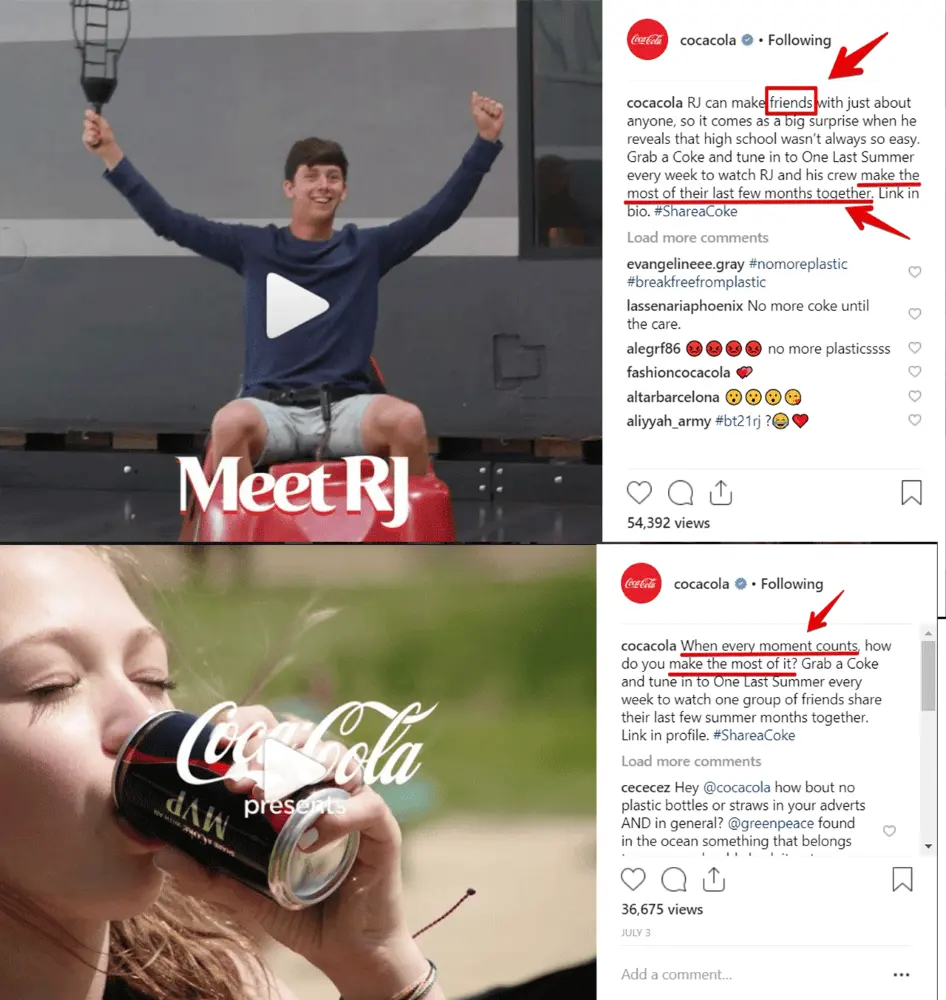
If we take another example, Charmin, you can see that whether they communicate offline or online, they maintain a playful tone.

How can you make sure your franchise brand stays consistent?
First, you’ll have to create a brand manual which includes details about your tone of voice, preferred professional terms, and general code of conduct. Every business should have one, no matter their stage in the journey to perfect branding.
(We’ve handpicked some of the best brand guideline examples for you.)
Then, in order to minimize errors, you can create “best practice” templates that are in line with your brand’s ethos and aesthetic.
This ensures no one in your company has to take matters into their own hands, because they can draw on templates that reflect your brand every time they create a new document.
If you’re using Marq, you can create & customize templates to easily create stunning content without having to start from scratch every time. And because of its innovative Brand Assets feature, you can make sure everyone is using the latest version of your branding elements. Fonts, colors and logos are all pre-loaded and ready to go.
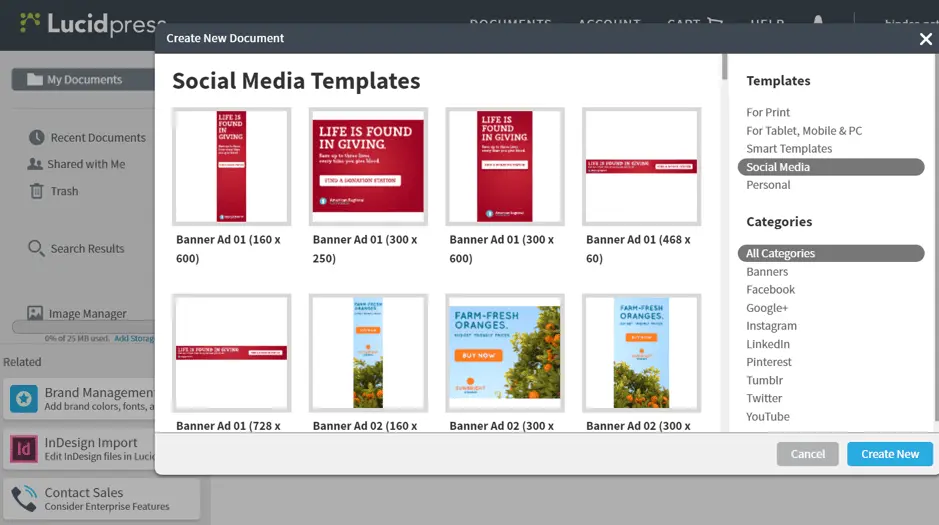
How can franchises maintain brand compliance across locations? Learn more in our free ebook, The complete guide to multi-location branding.

Before starting your efforts, make sure you can measure them
There’s an old adage that says half of the money invested in marketing is wasted. The problem is you don’t know which half.
Well, thanks to digital analytics, you can track your results so in-depth that you’d be amazed at how much leverage you have… if you measure the right things.
Here are just a couple of examples. Let’s say your marketing team developed two or three video messages for a certain audience, but you don’t know which one to choose.
It’s super easy. On Facebook, for example, you can check how much of your video was actually watched by a particular group.

If you compare it to television advertising, for example, you don’t get this level of accurate data. You can’t know whether a person left the room when the commercial started.
But, Facebook isn’t the only tool that allows you to track the results of your franchise advertising efforts.
If you run email marketing campaigns, you can see how many people opened your email and clicked on the offer inside.

Source: MailChimp
If you run any other digital marketing campaigns, you can check Google Analytics to see how much time people spend on your website, which campaign brought in the best results, where the most traffic comes from, and much more.

Source: Optimize Smart
Or, maybe you just bought a pizza franchise and you’re using local Google Ads. You can track how many times people called versus how much money you’ve invested and see if there’s a positive return on investment.
Ultimately, analytics don’t have to be limited to the online world. If you’re using offline marketing tactics like flyers or coupons, you can use codes to measure whether your campaign was a success.

Always keep an eye on trends
Marketing is first and foremost a battle for attention. If you don’t have people’s attention, you can’t communicate with them. If you can’t communicate, you can’t sell.
In the 50s, attention was on the newspapers, then on TV and radio.
Today, our attention is on social media. Messaging apps like Facebook Messenger are becoming more powerful.
Influencer marketing is growing, because they have people’s attention and they’ve already earned their trust.

Source: Google Trends
What’s next? Voice search & marketing will have a huge impact on consumer behavior. More than 35 million Americans used a voice-activated assistant at least once a month in 2017, according to eMarketer.

Coordinate local & national franchise marketing
There are many methods to handle franchise marketing. Sometimes, the franchisor and a corporate marketing team are wholly in charge. Other times, the franchisee takes on all marketing responsibilities. Most often, it’s a mix of the two.
It’s easy to see how this arrangement could cause confusion for your customers. But by coordinating your marketing efforts, your brand message will be strong and clear across all franchise locations.
Large-scale, national marketing campaigns
Here are some tips for coordinating large-scale marketing campaigns between the franchisor and franchisee.
Focus on the brand
In a franchise, the brand is often the selling point for customers. They know they can trust a certain brand and will support that franchise, no matter where they are. This is why it’s beneficial to focus on the overall brand image in your marketing efforts.
Provide a brand style guide
Franchisors can create a brand style guide for franchisees, to help them create on-brand materials and limit branding mistakes. It you aren’t sure how to create a brand style guide, take a look at this blog post for some killer examples.
Here at Marq, we’re pretty obsessed with staying on-brand and empowering everyone (even franchise owners who have no design experience) to create visual content. If you’re curious how Marq could streamline your franchise marketing, then check this out.
Communicate clearly & frequently
To maintain your brand image across multiple locations, communication is key. Set the precedent that there will be consistent communication regarding marketing efforts between the franchisor and franchise owners.
One area that’s often under-communicated is digital marketing strategy. The franchisor should coordinate website and social media creation with franchisees, so there aren’t multiple accounts that could confuse or misdirect customers.
Looking at these marketing strategies, the biggest factor is the brand. Build a strong brand identity that will give your franchises a good reputation, then give franchise owners the freedom to create their own marketing collateral using approved brand assets.
Small-scale, local marketing campaigns
Small-scale marketing strategies should focus on specific efforts in the local community. Franchises often have the good reputation of the larger brand, but localized marketing is what will win the community over and create a loyal fan-base.
By empowering franchisees to control their own marketing on a local level (and by giving them the tools to stay on-brand), individual franchise revenue will soar.
Here are more tips for localized, franchise-level marketing.
Find local sponsorships
Talk to local charities, sports teams or schools in the area to find opportunities to donate to a good cause and get some advertising. This is a great way to show community members that you’re invested in the area.
For example, when I was in high school, there was a Taco Time that always sponsored the school’s football and basketball teams. Their sponsorship included banners hanging up at the football field and inside the gym. They sold food at the concessions stand and had their logo printed on the game rosters. As you can imagine, my friends and I ate a lot of tacos.
This was a worthy investment for this franchisee, as it showed their support for the community and offered unique advertising opportunities. The owner of the Taco Time had a great relationship with the community and people loved going to his location.
Personalize your messages
When you’re advertising to a specific community, it’s important to personalize your messaging for your audience. Every community is different, and by catering to yours, customers will feel special and more inclined to support you.
A great example of marketing personalization is CrossFit gyms. Each gym (or “box,” in CrossFit lingo) has its own website and social media accounts that tailor their messages to the area where the gym is located. Whether it’s about the weather or events happening in the city, these gyms create a local identity for themselves that members can be part of.
Keep up-to-date
Encourage franchise owners to stay on top of trends and news as they create marketing for their franchises. Being in tune with the local news can help you spot opportunities and avoid embarrassing advertising mistakes.
Any time you post about current news or trends, make sure you do your research. An unfortunate example of this is DiGiorno. When the hashtags #whyistayed and #whyileft were trending on Twitter, DiGiorno tweeted “#whyistayed You had pizza.” The problem: these hashtags were dedicated to discussing and raising awareness of domestic abuse—an incredibly serious cause. Needless to say, many people were offended by the tweet and DiGiorno quickly apologized for its mistake.
Be where your audience is
This, of course, is one of the most important rules in marketing. No matter how clever and wonderful your marketing efforts are, if your audience doesn’t see them, then it’s a waste.
So, find out where your local audience is: Do they spend time on Facebook, Instagram or Twitter? Do they read the local newspaper? If so, that’s where you should be, too.
Be consistent with the brand
Much of the traction and business a franchise location enjoys comes from the brand name that it carries. To continue attracting and retaining that business, it’s important to stay true to the brand.
If the franchise brand is known for great customer service, then local managers have to make sure that customer service is a priority for them. Personalize each franchise to the local area, but stay true to the brand it represents. For example, maybe there’s a way to provide outstanding customer service that’s unique to your community.
A great example of this is Chick-fil-a. It’s a well-known fact that if you say “Thank you” to any Chick-fil-a employee, they will reply with “My pleasure.” Quality customer service is part of the Chick-fil-a brand, and customers can expect to receive the same level of customer service wherever they go. While each Chick-fil-a has its own concerted marketing efforts, they stay on-brand with their customer service.
Key takeaway
Marketing within a franchise can lead to miscommunication and overlap if the franchisor and franchisee do not coordinate their efforts. However, through communication and a good brand management system, your marketing efforts can complement one another and culminate in more success.
Before you start your franchise marketing strategy…
Everything starts with your ideal client in mind. From there, you decide which channels would bring you the best results, depending on your budget.
Next, you have to make sure your brand identity stays consistent across all channels—from your value proposition to your design elements.
Then, make sure you keep an eye on the latest trends in order to leverage first-mover advantages. This strategy will give your franchise business the best chance at standing out and finding success with your preferred customers.
Maintain brand consistency with Marq, the brand management platform for franchises. It’s perfect for franchise brands of any size.
There’s a good reason optimizing productivity is the holy grail of the sales world right now.
You just know you can do a lot more if you use software to automate repetitive tasks that eat up your resources.
Related: How RFP software helps you streamline RFP responses
One of the biggest challenges in sales is to organize information from multiple data sources, identify priorities and act on them.
If you’re reading this, then you already know you can tackle this issue (and others connected to it) with the right tools. But with a schedule like yours, it’s hard to find the time to build a list of potential solutions.
Assemble your tool stack from the list of options below to improve productivity and streamline your sales process.
How software sales tools get you in control of your time & resources
Whether you’re searching for leads or closing customers, your sales team needs all the help it can get.
The entire sales process can become significantly more effective when you:
1. Optimize the time you spend on repetitive tasks
The right platform integrates activities like emailing, calling and progress-tracking to keep salespeople engaged and boost productivity.
Instead of dealing with mindless tasks over and over again, empower them to achieve more. Give them the tools to use their skills, knowledge and time to close deals.
2. Automate manual tasks to increase your productivity & focus
Limit your sales software stack to just a few tools to avoid tech overhead and process disruption.
What really moves the needle is automating tasks such as outreach, follow-up, and reminders for key activities. [![]() ]
]
3. Collaborate in real time and disseminate best practices faster
When you keep information in silos, salespeople waste time testing approaches their colleagues already (in)validated through practice.
Build a scalable path to success by making it easy for sales reps to share their findings and collaborate in real time.
Look for software that can:
- auto-assign leads
- show you a deal’s status instantly
- allow salespeople to reply to each other’s unanswered emails in a common team inbox.
4. Improve consistency across your sales collateral
Mix sales with marketing & customer service to get higher success rates when pitching exigent customers.
When your sales proposals, e-signatures, reports, sales presentations, case studies or brochures look polished, you look more professional, too.
Implement tools salespeople can use to collaborate on creating and personalizing these assets fast and scalably, and reap the rewards.
5. Promote prioritization & faster decision-making
Some of the best sales tools on the market fixate on helping sales teams focus on what’s important.
Sales reps plan their time & efforts effectively when they have access to:
- complex lead scoring
- contextual insights
- behavior-based segmentation
Rich details about their prospect’s activity help skillful salespeople engage leads at the right moment and close deals faster.
6. Track progress effectively and gain more visibility
Another way you can use online sales tools to keep your pipeline flowing is to monitor progress with greater efficiency.
Use the right tech to integrate your data sources & sales activities, so you have one clear view of the process. Become better at setting realistic goals and forecasting revenue.
What makes online sales tools a good fit for you
Once you pinpoint the benefits you’re looking to get, consider these factors when evaluating your options.
The best apps for sales reps should:
- Have a strong onboarding process
- Include detailed documentation & help articles
- Feature user-friendly, intuitive design
- Have strong data security & privacy policies
- Provide automation for repetitive tasks
- Include robust features that work well together
- Be flexible and support customization
- Carry collaborative features that stimulate action
- Be compatible with your culture, needs & existing tools.
The software sales tool you choose should not:
- Have too steep of a learning curve
- Require spending more time to manage it than it saves
- Lock you into a closed ecosystem
- Create unnecessary burdens for IT & managers in charge of operations
- Require expensive custom development to integrate with your current setup
- Clutter your existing CRM with additional, useless custom fields
- Have obvious shortcomings that hinder your current sales process.
Some adjustment to new technology & processes is inherent when you implement new software, but that’s just in the short-term. Once they’re up and running, new tools should produce overwhelmingly positive results.
Now let’s dig into the options and see which of the sales tools below match your criteria.
Browse the best sales tools for your needs
The best tools for lead generation & prospecting
The selection of tools below covers a wide range of needs. From access to millions of GDPR-compliant leads to data enrichment, these software options can skyrocket your sales performance.
Features include:
- Prospect-tracking during key events, such as promotions or job changes
- Automated lead validation through AI-fueled sales assistants
- Surfacing new companies worth adding to your sales pipeline
- Quick & fair sales territory mapping
- Speeding up outreach with sales sequences and email & content templates
- Automatic confirmation of the lead’s intent to buy, and many more.
Which of these tools has the right combination of features for your sales team’s profile?
- Aircall
- Apollo
- CircleBack
- Close
- CloudSponge
- Cognism
- Conversica
- DataFox
- DealSheet
- DealSignal
- GetProfiles
- Groove
- Growbots
- Growlabs
- Leadfeeder
- LeadFuze
- LeadGenius
- LeadSquared
- LeanData
- MapAnything
- Nudge.ai
- Outreach
- PersistIQ
- RingResponse
- SalesWings
- ToutApp
- Vainu.io
- Velocify
The best software for your sales team’s productivity
Break down data silos across your entire company with these integration & automation platforms:
These are some of the best sales tools to capture & analyze customer-facing conversations. You can use them for both phone & video calls. Plus, they feed the details & notes into your CRM!
Use these encrypted file-sharing services to send larger sales collateral safely to your customers:
Create collaborative & flexible workflows for your sales team using any of these tools:
Help your sales reps collect valuable insights from your customers with professional, customizable and user-friendly surveys & forms:
Onboard new sales reps faster and share best practices across your team by recording & analyzing your sales videos. These software solutions help you personalize your outreach and add the human touch that can make the sale:
Get a lot more out of your email sales pitches with software tools such as:
- Cirrus Insight
- eMail-Prospector Pro
- FullContact
- GetResponse
- If No Reply
- Mailshake
- Nimble
- Opensense
- Reply
- Sales Navigator for Gmail
- SalesHandy
- Streak
- TruCadence
- Yesware
You can also try specific tools that increase productivity such as:
- Share your unified, real-time availability
- Save hundreds of hours spent on back-and-forth emails with AI-automated availability matching
- Capture & annotate screenshots, then share them securely
- Use screen recording to explain complex ideas
- Keep all your sales collateral in accessible, safe cloud storage
- Get personality insights to use in sales calls & meetings
- Improve response rates for cold outreach through deep personalization
The most powerful software apps for content sharing & management
Almost half of your customers (47%) consume between 3-5 pieces of content before engaging with a sales rep, studies show.
With that in mind, it’s clear that a high-performing sales team needs a strong process to create & share sales enablement collateral.
Here are some of the most effective online sales tools to help you build & leverage professional, polished content assets.
Make it easier for your customers to close the deal with these software options for sending & signing documents:
Eye-catching sales collateral (such as presentations, proposals, case studies & one-pagers) plays a big role in showcasing what you excel at.
With the right tools, you can respond to RFPs faster, reduce your reliance on designers, and improve brand consistency & compliance across your assets.
Collaborate with your colleagues and showcase the level of quality prospects can expect from you when they become your customers with these software tools:
- Adobe Spark
- Bit.ai
- Canva
- Haiku Deck
- Infogram
- Lucidpress
- Piktochart
- Prezi
- Proposify
- Qvidian
- Slidebean
- Slides
- Visme
Create & deliver high-converting sales videos that speak to your customers’ needs and inspire them to act:
Make sure your sales materials are impeccable and optimized for increased readability:
Outstanding customer relationship management (CRM) systems
A complex yet flexible CRM is the beating heart of any sales team. Our list of online sales tools wouldn’t be complete without it.
From dominant players who set the standard to AI-fueled options, this list has it all.
Which one of these solutions will speed up your sales process?
Leading performance management software for processes & training
No matter how much technology helps, managing & training your sales reps plays the biggest role in sales success.
These are some of the best tools to manage your sales reps and ensure they can focus & feel motivated to close deals:
- Altify
- Always Hired
- Ambition
- Betts Recruiting
- Detective by Charlie
- HireVue
- Hoopla
- LevelEleven
- Showpad
- Veelo
- Xactly
The most advanced analytics & reporting sales tools
Extracting insights from your ongoing sales process fuels your improvement & growth. As a result, this makes reliable & accurate reporting essential.
Sales reps can track their performance and find key ways to upgrade their approach with these analytics & reporting tools:
- 6sense
- Aviso
- Bombora
- Clari
- Datanyze
- FullStory
- Hotjar
- InsideSales
- People.ai
- Tableau
- Voogy
- Whoisvisiting
The best sales forecasting & market intelligence software
If you’re looking for the most reliable sales forecasting tools on the market, the list below will point you in the right direction:
- Artesian
- Clearbit
- DiscoverOrg
- D&B Hoovers
- Emissary
- EverString
- FirstRain
- MadKudu
- Mattermark
- ProfitWell
- Prospect.io
- TrendWatching
- ZoomInfo
Key takeaway
Sales software goes far beyond CRMs nowadays. There are plenty of robust tools to increase response rates & sales volumes. Guide your actions and help your sales team prioritize their prospects with data-driven insights, and you’ll gain a significant competitive advantage.
There’s no time like the present to leverage artificial intelligence & powerful integrations to drive better results.
Where’s the best place to start? Learn how Lucidpress can streamline the sales process for your team while building a strong brand for your organization.
Sales (of all kinds) should form the bottom line of your business. After all, sales are your prime profit focus. More importantly, well-played sales can lead to a snowball of success you need to make a go of things in the long-term.
But that’s pretty common knowledge for most B2B companies. However, what you might not realize is how you can leverage sales to work in your favor — even in a hyper-saturated market. And while doing so might be challenging at times, pairing strategy with account-based selling can help solidify your revenue, reputation, and goals.
Account-based sales is certainly not a new concept. But it is coming to the fore right now, with 86% of sales and marketing professionals using it to reach new customers. Injecting ABS into your sales strategy could go quite a long way towards helping you.
So, to help you get the ball rolling on your ABS strategy and sales, we’re going to delve into what precisely the account-based sales model is, and what it has to offer.
What is account-based selling?
Account-based selling is a B2B model that treats companies, also known as ‘accounts,’ as a single market. An ABS strategy does two things:
- Enables sales teams to make the most of existing resources; that way, teams don’t have to dedicate a singular rep to a singular, specific account.
- Empowers sales and marketing to create personalized content. So, instead of being forced to cast a wide marketing net that could potentially appeal to a variety of accounts, agents can create personalized content for every ABS effort
It’s worth noting that a solid ABS strategy involves a thorough prospect identification and vetting process. You need to be selective, so you’ll want to have a comprehensive identification and vetting process that sheds light on companies that genuinely fit your ABS criteria.
Not only does this allow you to implement the true power and capacity of your sales and marketing departments, but it also enables reps to target a prospect’s interests and pain points appropriately. From there, reps can provide personalized content with a much higher potential for ROI than your standardized sales approach.
Who is a good fit for account-based selling?
ABS can bring forward great revenue-boosting benefits to a company. That said, account-based selling doesn’t work for every company. Think of it this way — you can’t put a square peg in a round hole no matter how hard you try. The same applies to ABS: an ill-fitting account-based sales development could harm rather than help.
For instance, attempting to implement this method within a B2C sales model will lead to increased costs and tough-to-attain metrics. Even for B2B targeted organizations, ABS isn’t an automatic good fit. For example, if your B2B target is small-scale companies, the ABS sales method is unlikely to be a good fit and could leave you out of pocket.
So, when is an account-based selling model a sound choice?
Primarily, this comes down to companies that are dealing in complex B2B sales, enterprise-level organizations, and large-scale purchases. You should also have plenty of opportunities for upselling to ensure that the extra money and resources you use for each account have a guaranteed ROI potential.
How to implement account-based strategies
To get the ABS ball rolling, consult with your sales and marketing team. You want to uncover whether or not your company fits the criteria accordingly.
Once you’ve verified that account-based sales are the right fit for your sales team and company, there are a few things to keep in mind to implement ABS well and guarantee success every time.
- Step 1: Test your internal alignment. The ability of a sales and marketing team to work seamlessly together is a vital part of this process. As such, you need to test cloud processes and other collaborative efforts to make sure that this alignment works.
- Step 2: Build your ideal customer profile (ICP). We’ll talk more about the specifics and details that go into creating an ideal customer profile shortly, but it’s another vital piece of the puzzle. Only by building a picture of your ideal customer can you target accounts that have the right characteristics for you.
- Step 3: Measure relevant metrics to assess performance. Tracking performance is always vital, and your ABS strategy is no different. By measuring things like average deal size and lifetime value, you can determine where your account-based selling model is working, and where it needs attention.
How to find your ideal customer profile
An ideal customer profile, or ICP, is a detailed description of a prospective company.
To uncover your ideal customer profile, you’ll want to start by answering the following questions:
- Who is the ideal customer that would buy my product or services?
- What are the specific pain points my product or service offers a solution to?
- What are the specific benefits of my product or services?
- Is there a particular location for my customers?
- What is my ideal customer’s buying cycle?
Keep in mind this is a best-case, hypothetical scenario. Still, you also want these answers to be realistic and relative to the company because they’ll impact everything from your marketing team’s content strategy to your account-based approach. So it probably goes without saying, but you need to get this right.
From there, you’ll want to apply this information directly to your prospecting efforts. Start by identifying the firmographics and behaviors of your perfect customer base or, otherwise known as, an account-based audience. In general, these types of characteristics are directly connected to your target vertical and industry. Consider basics like:
- Industry
- Company size
- Buying motivations and triggers
- Location
- Lifetime customer value
This type of information allows reps to target account-based sales to companies that have a higher, more dependable chance of a conversion. Be sure to leverage these metrics throughout prospecting conversations, emails, and so forth.
At the end of the day, creating an ideal customer profile is the key to unlocking an effective ABS sales strategy. An ideal customer profile is your North Star of ABS — it can help you layout a roadmap for your prospect and when in doubt, shed light on whether or not a prospect is a right fit for your strategy.
The importance of personalized content and marketing
When created with your ideal customer profile in mind, personalized content and marketing can help reps seal the deal. Personalized content that looks and feels tailored will flatter and impress your prospects. Plus, it enables you to stand out against a crowd and empowers you to set your ABS strategy in motion. In getting this right, you can make sure you cater to and alleviate every pain point your prospect faces, making your company the most appealing option.
To create successful, personalized content that truly reflects both the ABS strategy and prospect, internal sales and marketing teams must combine their collective knowledge and expertise.
After all, sales reps genuinely understand what customers are searching for — and creative teams are well-versed in crafting beautiful, on-brand content.
However, content creation typically falls to the creative or marketing team, and the knowledge regarding customer needs or pain points can get lost in translation, rendering that valuable personalized content somewhat obsolete.
Given the opportunity, sales and marketing teams should work collaboratively to create sales enablement content. But in place of that, sales teams can use brand templating platforms (complete with professionally-designed, on-brand template galleries) to their advantage. A brand templating platform helps ensure that the ICP content accurately reflects a prospect’s needs and pain points — and the creative team can continue trucking along on other projects.
Tools you can use
Integration is another critical component of a successful ABS strategy. So you’ll need to consider tool implementation across marketing and sales teams. Remember that you’re approaching sales in a way you may never have done before. As such, there’s a chance that you’ve never even considered how these departments could work together.
- Easy content creation — Given the importance of content creation mentioned above, your first focus should be on cloud-based platforms that offer approachable, simple, and straightforward content collaborations. Brand templating platforms, like Lucidpress, empower sales and marketing teams to customize, lock, and adjust cloud-based content in real-time for improved results. Even better, this program then frees up your creative team and enables anyone to create or share content across your marketing landscape.
- Communication tools — It’s likely that your marketing and sales teams work from different areas in your office, or even on different floors, no? Moving your entire office around for the sake of account-based selling would be disruptive and not particularly useful from a productivity standpoint. Instead, implement one of the many remote communication platforms now available online. With cutting-edge options like Slack, your team will even be able to create separate chat groups for each prospective account. That can go a long way towards guaranteeing those communications, and therefore accounts, are better managed moving forward.
- CRM — You’ll want to double-check and make sure that whatever CRM platform you currently use is ABS-friendly. Again, this can help to integrate your sales and marketing teams. A decent collaborative CRM also guarantees repeatable sales and processes that make account-based sales easier than ever.
How to measure success
Since account-based selling is a data-driven strategy, you’ll want to measure your success based on quantifiable metrics. Fundamentally, ABS metrics are very similar to the analytics you’ve been receiving from your sales efforts (until now). So you’ll want to measure things like customer reach, MQA, SQA, attention, deal duration, contract value, and so forth.
That said, you’ll also need to approach metrics with ABS in mind to truly measure success here. To do that, you must consider things like —
- Percentage of key contacts from each target account
- Revenue generated from accounts
- Interactions and interest over time
- Lifetime customer value (cross-sales, repeat sales, etc.)
- Account improvement over time
You can garner each of these insights by simply keeping a close eye on sales and also content engagement. Then, you’ll be able to measure whether your efforts are moving in the right direction and whether your account-based selling model needs further attention to pull the profits you desire.
Account-based marketing — also known as ABM — involves tailoring your marketing approach to a market of one. So, rather than leaning on old, homogenized, one-size-fits-all strategies, ABM strategies require personalized, custom-fit interactions with your prospects, which is where account-based marketing tools come into play.
To carry out a successful account-based marketing strategy, it’s crucial that you utilize tools and software designed specifically for ABM and/or abm companies. After all, it’s easy to try to make do with what you’ve got, but it doesn’t necessarily translate into a winning ABM strategy.
Let’s take a look at what exactly account-based marketing is, how it can benefit your business, and which account-based marketing tools and software you should be considering.
What Is account-based marketing (ABM)?
As we mentioned above, account-based marketing is best described as a marketing strategy that’s tailor-made to reflect a prospect or target account. Everything — from marketing content to emails — must address and resonate with your prospect. This type of strategy empowers reps to directly address a prospect’s needs and pain points, boosting the chance of conversion and success.
Keep in mind, account-based marketing is best-suited for B2B companies. Typically, enterprise-level sales organizations execute ABM strategies in close partnership with marketers familiar with ABM. To support ABM efforts, there are specific account-based marketing tools that help you and your reps identify leads, address pain points, and fill the gaps accordingly.
The benefits of account-based marketing (ABM)
Account-based marketing offers a range of benefits, especially to B2B companies and sales organizations. It’s not designed to replace your larger marketing efforts, but strategically adding it to your arsenal can help you land important, large accounts or connect with multiple buyers, empowering you to leverage existing accounts.
- Stand out from the crowd — The more customized your content, the higher chance you have of standing out against your competitor’s outreach efforts that look and feel vanilla.
- Focus on the individual needs of each account — Since ABM is so personalized to your target audience, this helps ensure that your marketing campaigns truly connect with the decision-makers within the prospective organization.
- Quick and easily measure campaign success — Casting a wide net with your marketing makes it difficult to attribute your efforts directly to revenue gained. But when you target one specific account, it’s easier to connect revenue to your ABM marketing campaigns because you know the specific details that propelled the conversion.
- Save time and money — ABM strategies enables marketers to narrow down their efforts, so they can identify true business value and avoid wasting time or effort. Dedicating parts of your marketing budget to ABM means you can secure a strong client base, along with loyal customers that earn you more money.
- Shorten your sales cycle — Lead generation takes time. However, with ABM strategies, there’s very little to no need to conduct lead generation because you know who exactly you’re speaking to. So instead of spending time on leads that may or may not convert, you can focus on those that will.
- Strengthen existing relationships — Account-based marketing gives you the opportunity to strengthen relationships with existing clients. Plus, it’s easier (and cheaper) to retain customers than have to chase new ones.
The best account-based marketing (ABM) tools and software
In order to create and implement a successful account-based marketing strategy, you need to have the right tools. ABM-specific software (also known as abm vendors) and account-based marketing tools, like Demandbase, help you generate new leads, manage multiple accounts effectively, and distribute marketing materials quickly.
Demandbase
Demandbase is a popular platform that’s built specifically for ABM strategies. The beauty of Demandbase is that you don’t have to leave the platform in order to access important pieces of information. And through Demandbase, you can easily target your prospective audience, engage quickly, measure success, and secure conversion.
Leadfeeder
Have you ever wondered who is visiting your website (and what they want)? Leadfeeder demystifies this question by showing you (thanks to a little help from Google Analytics) who has visited your website in the last 30 days.
Not only does this help your marketing and sales teams to identify new accounts to focus on, but it empowers you with names and other relevant information that makes an ABM strategy all the more powerful. In turn, you save time and energy by having to avoid conducting a manual, hands-on search and it enables reps to truly focus on accounts that want and need your services.
Leadfeeder is a step in the right direction when you need to get the ball rolling on leads or build a foundation for outreach. Plus, it helps you monitor target accounts with various integration capabilities, alerts, and retargeting efforts via LinkedIn, Slack, or email.
Jabmo
Jabmo is a marketing automation platform that serves personalized ads to known and anonymous buyers relative to your target accounts. It captures anonymous buyer activity and offers account-based IP advertising and website personalization. Other features include ad retargeting, analytics, sales enablement tools, as well as CRM and marketing automation integrations. You can even gain marketing insights down to the account level, including ads, retargeting, email, social and paid search.
With Jabmo, it’s easy to see which leads are most important — and which ones can get put on the back burner. More importantly, it’s built with global manufacturing in mind and helps these types of companies see the actuality of their marketing efforts instead of having to guess.
Lucidpress
Content is an important part of ABM. But it can be difficult to manage and create batches (or one-off pieces too) of unique content — especially when you need it personalized for multiple accounts. To prevent rogue content from arising from your sales team, Lucidpress levels the playing field through brand templating.
Lucidpress makes creating content easy and accessible for anyone, while also maintaining and ensuring brand consistency through its lockable (and customizable) brand templates. You’ve got a wide variety of professionally-designed, ready-to-go templates to choose from — flyers and newsletters or social media ads — so sales reps can get started quickly and make personalized, on-brand content. Plus, with help from the data automation feature, reps can quickly populate pre-existing CRM tidbits, reducing the chance of typos or other errors. And when it comes time to share the finished product, sales reps can print, email, or embed content however they see fit.
Ultimately, personalized content helps enhance your ABM — and Lucidpress makes incorporating that personalized step less complicated.
DataFox
With Oracle DataFox, you can easily search for prospects that are comparable to your existing customers. Here you’ll uncover valuable leads that are most likely to convert, so you can create targeted ABM efforts.
DataFox uses an AI extraction engine to gather data-level pieces of information. One extrapolated, the data is then double-checked by a QC team for accuracy and validity. Plus, DataFox has automatic updates, so you’ll always have up-to-date information — and it provides more than 70 firmographic data points and 68 types of signals.
Alternatively, if you’re overwhelmed by the sheer amount of options, you can easily filter based on company criteria or other identifiers, so you gain the transparency and insight you need to maintain a solid ABM strategy.
Owler
Owler alerts you to key events, related to your prospects and current accounts so that you stay in the loop and know when something important happens, giving you an opportunity to reach out and connect. Owler will auto populate a concise company profile, so your sales team doesn’t need to research accounts manually. And comparable to Google alerts or notifications on your phone, it sends you prospect-related push news and alerts, making it easy for you to reach out when the time is right. Owler also integrates with your CRM, providing you with a seamless connection between interfaces, while the daily snapshot offers news and updates on the companies that you follow.
Getting started with Owler is easy. And it’s even easier to customize your alerts or filters, so whether you’re looking to track leads from Salesforce and Hubspot or keep tabs on your most important accounts, you can easily sync Owler to get the job done.
ActiveDemand
ActiveDemand is designed specifically for ABM. It features behavioral segmentation, predictive personalization, behavioral retargeting, lead scoring and sales and marketing integration.The behavioral segmentation software aggregates data and automatically personalizes the engagement experience (based on the aggregated data) for each target account. Meanwhile, the predictive content targeting is based on the exact industries and language of your prospects, which enables ActiveDemand to serve up content that resonates with them and reflects their pain points or needs.
ActiveDemand touts a wide range of tools — in one platform, so marketers can create quick, simple, and easy ABM campaigns. So, for those looking to get their ABM strategies off the ground, ActiveDemand is a great resource and one-stop-shop.
Engagio
Like ActiveDemand, Engagio is another ABM vendor with supportive tools and functionalities to help you at all stages of your ABM strategy. With Engagio, marketers can easily generate lists of leads or review the performance of your campaigns. Engagio makes it easy to manage all facets of your campaign, so you can focus on targeting the right people while aligning your marketing team for the best omnichannel experience.
Leverage account-based marketing (ABM) tools
Account-based marketing is a useful approach to marketing for many B2B businesses. Having the right ABM tools makes it easy to save time and money while producing the results that you want. Automation, in particular, makes it much simpler to get the information you need and carry out ABM techniques to make the most of your accounts.
Elevate your ABM strategy with Lucidpress.
IWant It Now GIF from Iwantit GIFshttps://tenor.com/embed.js
Welcome to a gluttonous world of instant gratification, one-day shipping, streaming on demand and fast fashion. Thanks to technology, we want what we want right now, and we can usually get it that fast.
Product development is no different. The quicker we can get a new product to market, the faster we can entice buyers and make that money. Speed to market, a clunky phrase that is just what it sounds like, means how fast you can get your product or service on the market — from inception to an actual, purchasable good.
With so much innovation and competition in the marketplace today, being the first to debut a new product or feature has its advantages. Namely, increased revenue. If you can get a product to market before your competitors and you’re the only person offering it, you’ll be snapping up a much larger percentage of consumers.
So, the faster your speed to market, the more successful your company is. Let’s get cracking.
7 ways to improve speed to market
While you want to move fast, you don’t want to cut corners. Here’s what you need to do to get a quality product on the market quickly.
1. Create a solid strategy
The first step of embarking on any new product launch is to preplan the hell out of it. You want to have a plan in place that’s been carefully thought out and thoroughly vetted by your key stakeholders. It also needs to be feasible and reasonable — double-check that it’s actually possible to get everything done in the time allotted.
This will require having a deep understanding of each team’s and contributor’s process, so make sure you’re talking to everyone involved and communicating like an important deadline depends on it.
2. Embrace cross-functional communication
Improving speed to market won’t happen in a silo. You’re going to need a lot of clear, cross-team communication. Good communication — period — is pretty much the name of the game for any successful team effort. Get everyone in the habit of updating each other regularly, whether this looks like scheduled weekly syncs or daily updates in Slack each morning.
It’s easy to get hyper-focused on your own product development tasks and your own team. Encouraging different teams and different roles to communicate more openly will help everyone take a bird’s eye view and work toward your end goal.
3. Hire the best project manager you can afford
These people are worth their weight in gold. A good project manager will keep everyone informed and make cross-functional communication feel easy. They’ll schedule your meetings, take notes, set deadlines and follow up to make sure people are completing things when they say they will. They’ll keep you on budget, on track and on time.
The best project managers will even keep things upbeat and boost morale. When you find a good project manager, hold them close and never let them go.
4. Sniff out the bottlenecks
Once product development is underway, you can start to take a look at the processes you’ve put in place. What’s working well? What’s not? Identify where work is slowing down, so you can figure out how to correct it.
Many teams use a retrospective meeting every two or four weeks to talk about successes and failures in their work process. Schedule something similar at a cadence that makes sense for your speed-to-market plan. This will provide a place to get into the nitty-gritty of your process, make adjustments as needed and eliminate bottlenecks.
5. Consider outsourcing — or don’t
When you’re trying to accelerate your speed to market, it can be tempting to outsource some parts of your process. Outsourcing will save on labor and it can often cut costs. On the other hand, you won’t have the same control as you do with things kept in house, and contracting with another company can lengthen timelines with all the back-and-forth communication that’s needed.
Weigh your options beforehand. Do your internal teams have the capability to produce everything themselves? Do they need training? Consider the cost and time required for outsourcing versus doing things on site.
6. Stay on message
When you’ve got a new and exciting project, it’s only natural to want to make it the best it can possibly be. But when you’re on a serious deadline, you can’t get distracted by extras. Make sure that everything you’re planning for your new product is absolutely essential. Improving speed to market is a time to focus only on have-to-haves rather than nice-to-haves.
7. Set weekly goals
With longer projects like launching a new product, it’s easy to get lost in the enormousness of what lies ahead. Your team needs bite-size milestones they can hit each week to keep them anchored.
Break the project up into smaller and smaller segments until everyone has tasks they can reasonably accomplish each week. This will keep people motivated and give you a clear idea of where you’re at in your trajectory.
How to develop greater go-to-market agility
So you’ve got this great new product — now you need to create a foolproof sales plan. You want the right sales strategy so you can reach the people you need to and lure them in with your shiny, new offer.
When you’re working on your go-to-market strategy, the first thing you want to ask is if your sales team can get the content they want when they need it. For your sales reps to move quickly, they need to have access to the sales collateral that will help them appeal to leads.
Next, take a look at whether this sales content can be customized for the customer. Content that’s been customized to be industry- or role-specific for your prospect is much more persuasive and effective than something that’s been watered down to speak to a broad audience.
How can you improve sales acceleration and make sure your sales team has access to customized content?
- Create a centralized content hub where everyone can quickly get what they need. Organize it in a way that’s easy to navigate for your sales team.
- Supply your content hub with customizable pieces of collateral so anyone can go in, grab a piece of content and personalize it for their prospect.
A system like this will ensure that your sales reps never have to wait for materials they need. Sales enablement collateral often comes into play near the end of the sales cycle, meaning your reps need to be able to move quickly — they don’t have time to wait. If they can make their own content right when they need it, your go-to-market agility (and by extension, speed to market) is that much better.
But how exactly do you come up with easily customizable content? That’s where templates come in. Create a few standard templates with customizable elements that can be adapted as messaging and market circumstances change. Templatized content means your sales reps will never go without a convincing piece of material, and you’ll be looking at that many more successful deals.
Equip your sales team with the right content
Preparing your sales reps to move fast is the final stage of a solid speed-to-market strategy. And effective sales content will help your team do what they’re best at. It just so happens that we have an entire guide about creating a sales enablement program using customized content. Check it out if you want to learn more: How to achieve consistent storytelling across your sales org.
Most companies strive for market penetration as soon as they enter a new market to launch a new product. The hope is to enter the market swiftly and capture a sizable market share.
What is market penetration? In simple terms, it’s planning how to grow your business in an already thriving market where similar products exist. When you enter an already established market, you need to have strong implementation and execution strategies in order to get the upper hand against your competitors. This is where market penetration strategies come into play.
Market penetration strategies carry a low amount of risk and are ideal tactics for business growth, especially for startups that are low on cash or can’t invest in riskier growth strategies. Entering an established market is a safe bet as it already guarantees a need for products in your industry.
Before you can start considering which strategy to move forward with, it’s important to note that market penetration can be looked at as a metric or an activity.
Market penetration as a metric
Market penetration as a metric assesses how much of a product is being sold in relation to the total estimated market for that product. This metric is expressed as a percentage. When market penetration is viewed as a metric, it can also be called the market penetration rate.
See the simple calculation below that you can follow to get the market penetration rate:
Market penetration rate = (number of customers ÷ target market size) x 100
This can be calculated if you know your total addressable market (TAM), which is the total amount of money you can make selling your product or service. Sometimes calculating your market size can be tricky, especially depending on the nature of your product. Plus, your potential customer base could be global and your target audience may be “everyone.” The more particular you can be with your ideal audience demographics, the easier it will be for you to calculate.
To know whether or not your product or business is doing well once you’ve calculated your market penetration rate, consider this — the average rate for market penetration for a consumer product should be around 2% to 6%, whereas a business product can range anywhere from 10% to 40%. If you’re able to hone your product to where you can capture around 10% of the TAM in your industry, you’ll be doing quite well.
Apple offers a good example of successful market penetration. Within the smartphone industry, the iPhone has a market penetration rate of 19.2%, whereas smaller brands like Huawei have 10.2%.
Market penetration as an activity
As an activity, market penetration is the process of going to market with a product (in an existing market where current or similar products already exist) and taking market share from competing companies. This can also be known as market penetration strategy.
Market penetration as an activity first stemmed from the Ansoff Matrix. The Ansoff Matrix was developed in 1957 by Igor Ansoff and is used to help companies plan their strategies for future growth. It’s a 2×2 matrix that represents four different business growth strategies including market penetration, product development strategy, market development strategy and diversification strategy.
Market Penetration Strategies
There are several different ways you can approach market penetration and different strategies to apply in order to achieve success. We’ll highlight five strategies below.
1. Improving marketing effectiveness
This may feel like a “no duh” approach, but updating your content and analyzing its effectiveness can go a long way in market penetration. Consider these three ways to improve your marketing effectiveness: content adoption, content effectiveness or content customization.
Content adoption rate
How much of your content is actually being used? If your marketing team is churning out content that is rarely used by the rest of your business, it could be because that content is ineffective (see below for more about that) or because the content is too difficult to find or use. By adopting brand templating, your marketing team can organize templated content in one location that stakeholders can quickly find and customize to their needs.
Content effectiveness
If you’re looking to improve your marketing effectiveness, you need to ensure that your content is on brand and on message so you don’t lose customers to irrelevant or low quality content. Brand education, brand consistency controls and regular feedback from customers and stakeholders on which content is most effective is critical to stand out in a saturated market.
Content customization
Empowering everyone in your organization to customize content is a powerful way to improve content effectiveness. Provide your staff with tools like templates that they can adapt and personalize based on customer and industry insights.
2. Increasing brand awareness
Similar to improving marketing effectiveness, another good market penetration strategy is to increase brand awareness. You can do so through several different ways including branded packaging, upping your presence on social media, working with influencers or leaning into your brand story and personality.
No matter which approach you take with increasing your brand awareness, you have to be consistent with your brand across all platforms and channels. With a consistent brand voice and aesthetic, potential customers can get to know your brand and recognize it easily.
3. Enabling multiple distribution channels
In today’s digital world, it’s no longer enough to simply sell through your personal website or in a brick and mortar shop. You need to post your content on multiple channels, as well as sell your product or service through different distribution channels as part of your market penetration strategy. That can include internal sales, channel sales partners, digital channels, franchises or strategic alliances.
If you’re looking at acquisition, know that by buying a company within your industry, you can practically buy the customer base and the market share along with it. Or, you can buy the competition and shut them down. This business plan may not be accessible for small startups, but may be feasible for more established companies.
If you can’t buy out your competitors, then making a strategic alliance as channel partners with similar companies will help you to capture their audience while also widening your market. Remember to put brand guidelines in place to keep your messaging consistent — it will ultimately make your channel partners’ lives easier too.
Creating a business franchise can also be a well-planned market strategy helping you to stand out among competitors. Franchising can be a cost-effective way to quickly get you into a market, because you won’t be footing the cost for every location. In franchising, franchisees use the brand and open their own location, while the franchisor gets royalties from the profits.
To help with brand consistency across franchises, create a brand manual that will detail things like your brand’s voice and tone, outline a general code of conduct, and include best practices templates. These templates will ensure that franchisees won’t stray from correct branding. Using templates like those provided by Lucidpress will help you create and customize templates so your franchises won’t have to create content from scratch. You can also use a content marketing platform to create, manage, distribute and organize all of your content in one place.
4. Changing pricing
Another effective market penetration strategy is through lowering or raising your prices. In fact, it’s one of the most widely used tactics. Lowering the price of a product with the intent of increasing sales is considered a price adjustment tactic. After analyzing your competitors’ prices, offering lower prices or an openly discounted price (that will be raised later on) can help swing business your way. If you do take this approach, be careful, as overdoing it can lead to the opposite effect that you’re hoping for.
5. Updating or launching products
Small adjustments to your product or service can make a big difference in your market penetration strategy. Reaching out to customers or clients through surveys or researching competitors can help you understand what your audience is looking for along with what they’re saying about your current products. By listening to your customers you can pinpoint essential functions or features that they want. If done correctly, you could end up giving your market something they need but can’t find with any other company.
Whether you choose any one of these tactics to help your business grow, it’s important to note that market penetration won’t affect your overall marketing strategy for your business. Rather, it will bring solid growth potential and increase revenue. However, each of these strategies will require strong implementation and execution in order to compete and grow alongside your competitors. So be ready to stick to your guns and don’t give up too soon.
Want to create a more memorable, consistent brand? Check out our free ebook — The extra 1%: Delivering a memorable content experience.
Recipes are relatively easy to follow. They’re designed to be replicated and, to some degree, guarantee an element of success. Take chocolate chip cookies for example. They’re hard to screw up and generally liked by most folks.
The same concept applies to marketing. Certain marketing strategies, aka your chocolate chip cookies, are designed to succeed — but that doesn’t mean they work for everyone. As in: one size does not fit all.
Alternatively, you need to put a new, customer-friendly spin on your go-to recipes. AKA, swap out an egg substitute for those who don’t consume eggs, or maybe use a gluten-free flour for those who are allergic. Minor changes in your recipe can make a world of difference. And doing so can ensure your marketing campaigns actually move the needle and resonate with target audiences.
So, while we head out to the store to grab some cookie baking supplies, we’ll leave you to glean inspiration from some excellent marketing campaign examples.
11 examples of great marketing initiatives that move the needle
Interactive scoring quiz
Who worked on it: Plain writing team — Derek Gillette
What they did: “Schools will need to consider and prepare for things such as purchasing equipment, training instructors, getting board or executive level approval, and designing their course pathways……To assist, we designed a ‘Readiness Quiz’ to help educators understand where they were at in the process, including a downloadable guide at the end walking them step by step through the outstanding items.”
Why it was effective: “The quiz acted as a first step for prospects, giving them clarity, and then pointing them to the next best resources, such as course demos, presentations, equipment lists or an application. The results of the quiz were also fed back into the marketing database, making it easy for sales or field teams to follow-up in a meaningful way with prospects.”
Additional context: Readiness quiz

Customer affinities
Who worked on it: Cricket Depot — Content creators, content strategist and founder (Jeff Neal)
What they did: “To boost our conversion rate, we created ‘supplemental’ articles that complimented the roaches we sell. When we started, our content focused on the health benefits of crickets. This was decent content. But it attracted people who already knew they wanted crickets as feeders for the reptiles…. Instead, we pivoted our content strategy, and started writing care guides for popular reptiles like bearded dragons and leopard geckos.”
Why it was effective: “These care guides brought in a whole new group of people that were unaware they could buy crickets online. When they discovered our content, they then discovered they could buy from our store, which led to a very low 36% bounce rate, and a whopping 10% ecommerce conversion rate…..so content that indirectly helps our customers was a great way to quickly boost our conversion rates.”
Additional context:

Timely content
Who worked on it: Filter King — Writer
What they did: “Educating people on all things to do with the home offers us great leverage — reparation, improvements and safety. When Covid arrived, and it was evidence that it was here for the long ride, we created a Covid-centric marketing campaign. We wanted to educate people on how air filters are working to help in the battle against Covid. One huge noticable change due to Covid is how everyone is wearing a mask — Masks are basically air filters. So if you are to wear one while outside, why not ensure your home has high quality air filters to protect it from outside elements? Because, ultimately, you protect those indoors — your friends, family and loved ones. We sent one of our best writers to pull up the research and data of our air filters and to compile them into an educative, informative, and easy-to-read and understand blog post.”
Why it was effective: “It has taught us that when creating blog posts, we should concentrate on real world events and trends. If we want to get a larger response we need to be relevant.”
Additional context: “We sent the email with weekly blog posts — but the customer reaction was incomparable than emails before. We had a 39% open rate, with a 16% CTR!”
Mini product samples
Who worked on it: PLM — Helena Gutierrez Alvarez
What they did: “We reached out to potential prospects over Linkedin and shared a microlearning series, similar to what you can see at our company page at Linkedin. After sending three pieces of microlearning content, we invited our prospects to a strategy session.”
Why it was effective: It got people in the door! And in the product.
Additional context: “We sent 200 messages over linkedin and got three new customers from this campaign, it was a great success.”
Who worked on it: Mountain View — Matthew Lally, founder of TheGiftYak
What they did: “Post-covid world we shifted content strategy to heavily favor work from home and remote working productivity. The team worked hard to analyze the customer behavior (both large enterprise businesses and small business owners) and the shift that was occurring in our organic and paid advertising data. This led to a lot of whitepaper and blog content, as well as heavy paid advertising investment shifts. We also helped the client spin up and launch a completely new product offering.”
Why it was effective: “It was a free version of an adjacent digital product and allowed us to further tap into our core markets at a very fast pace.”
Additional context: “Our growth didn’t index as high as e-commerce clients during this period, but we had to have seen 20-30% higher ROI than other B2B brands that failed to execute.”
Virtual concert
Who worked on it: Fortnite Team — written about in The Verge
What they did: “Travis Scott’s April (2020) concert in the metaverse of Fortnite’s Battle Royale was an ingenious spectacle that effectively allowed Scott to release his new track to over 12.3 million participants.”
Why it was effective: “The partnership was ingenious because it included an entire ecosystem of IRL and avatar merch, tons of PR buzz, and a stunning production value while everyone was under Covid stay-at-home orders thus bringing more people into Fortnite and Scott’s fanbase and setting an all-time record for Epic Games.”
Additional context:

User-generated content
Who worked on it: Premium Joy — Hassan Alnassir, founder and owner
What they did: “We ran an online contest through Gleam using our products as the prizes and the goal was collecting high quality user generated content (namely funny children videos) for marketing purposes…..Those selected contest videos will be utilized in a future blog post and YouTube video to promote our business (i.e., content marketing).”
Why it was effective: “The valuable $100+ contest prizes attracted several video submissions from customers out of which the best five were awarded.”
Augmented reality
Who worked on it: CocoSign — Caroline
What they did: “Asos — a famous British fashion and cosmetic brand launched an innovative feature for their mobile app. This feature is named ‘Virtual Catwalk’ and it utilizes Augmented Reality technology in order to work. Through it, users can point their smartphone towards any surface and watch the models walking in that set on their mobile as if they are in front of them. This feature enabled buyers to see Asos products in a better way. Increasing the interest of buyers and clarifying the product view, the organization could improve its online sales efficiently even in pandemic times.”
Why it was effective: “It is one of the best (indirect) marketing initiatives that has an element of surprise and curiosity alongside the power to educate buyers.”
Additional context: “Augmented reality helps virtually connect consumers with products and services without physically going to a retail store. Thus, it is a great marketing medium with consumers putting a high value on convenience. When they can test out products without leaving their homes, people are more likely to buy them online.” — Stephen Light, CMO of Nolah Mattress
Celebrity collaboration
Who worked on it: Just Eats — McCann Creative and Snoop Dog
What they did: “Equipped with a tagline you can’t help but hum, Just Eat has unleashed its secret weapon upon the festive season, leveraging the rapper’s popularity to draw attention to its food delivery service this Christmas…..The rapper first gave Just Eat the Snoop Dogg treatment back in May. Billed as ’this year’s biggest collaboration’’ the campaign saw Snoop jazz up its jingle – ’Did Somebody Say Just Eat?’ – doggystyle. Created by McCann, who won the newly-unified account back in 2018, the fresh tagline was a marked departure from the reign of Karmarama which focused on the ’magical world’ of Just Eat’s service.” — The Drum, Snoop Dogg fronts Just Eat’s festive ad spitting bars about fried chicken stockings
Why it was effective: “Globally, the Dutch-based business — which reportedly paid rap star Snoop Dogg £5.3million to front its summer ad campaign — racked up orders of 151.4-million in the quarter to the end of September.” — Metro UK, Business briefing: Rap boost — Snoop Dogg in Just Eat ad
Interactive video content
Who worked on it: Tate Law — Stanley Tate
What they did: “Tate Law is an organization that helps students with their student loan problems. We’ve helped manage $400 million worth of student loans so far. Last year, because of the pandemic we were forced to go 100% remote. This took a toll on our sales process and we were forced to rely on online channels only. Thanks to referrals and some online funnels we were able to bring qualified traffic to our homepage. But our conversion rates were quite low. After a lot of experimentation, we finally decided to settle on a video chatbot that would reply with pre-recorded videos of mine. It would eventually lead them to schedule a call with me. It was an instant hit. Our conversion improved by 654%.
Why it was effective: “It was a huge success because it respected our customers’ time. They were given hyper-specific information based on what they asked for. It was such a contrasting experience compared to an explainer video explaining the whole service.”
Additional context: “Many delighted customers said that the whole experience mimicked a live video call and gave a personal touch. It was a very efficient way to give them a feel of what kind of person I am and how I work. The best part — being a bot, it works 24/7/365!”
Digital PR
Who worked on it: NeoMam Studios
What they did: “World heritage sites exist in constant danger of degradation or destruction. From militants to motorists, earthquakes to urbanization, these meaningful landmarks face both human-made and natural threats.
UNESCO’s List of World Heritage in Danger draws attention to sites at risk of losing the characteristics that make them special. By definition, these structures are significant to ‘all the peoples of the world……’ We worked with architects, Jelena Popovic and Keremcan Kirilmaz and industrial designer Erdem Batirbek to research and illustrate six of these legendary locations for the best online experience: a series of gif animations reconstructing each site from how it looks now to how it looked when first built.”
Why it was effective: Ultimately, they acquired 211 backlinks from unique domains due to this initiative. Additionally, “time doesn’t stand still. Human culture is built from moving parts. The way we define, preserve, and interact with sites of importance says as much about who we are as the monuments themselves.”
Holiday-focused campaign
Who worked on it: NASA’s Exoplanet Exploration Program Office
What they did: “With Halloween just around the corner, NASA has released its latest Galaxy of Horrors posters. Presented in the style of vintage horror movie advertisements, the new posters feature a “dead” galaxy, an explosive gamma ray burst caused by colliding stellar corpses, and ever-elusive dark matter; the posters are also available in Spanish.”
Why it was effective: “‘The poster art is a really fun way to imagine one of these happening,” said Racusin. “But I wouldn’t want to be those space travelers!’”
Additional context: “As fun and creative as all three posters are, they’re based on real phenomena. In a dead galaxy, new star birth has ceased and most remaining stars are the long-lived variety, which are small and red, giving the galaxy a crimson glow. Likewise, when dead stars collide, they sometimes create a gamma ray burst, or the brightest type of explosion in the universe. And while dark matter may sound like it’s right out of a Halloween tale, its gravity keeps stars inside galaxies and hold groups of galaxies together in clusters — yet scientists don’t know what this invisible stuff is made of.”
At the end of the day, the core commonality between all these marketing strategies is a memorable content experience. So, yes, while it may take extra time or creative energy to think outside the box and concoct a marketing initiative on par with any of the examples above, the long-term benefits outweigh the short term ones. Because to be memorable is to be reliable — and to be reliable, as an organization, gets you so much further than your competitors.
To learn more about how to deliver the extra 1% to your target audiences time and time again, check out our ebook.